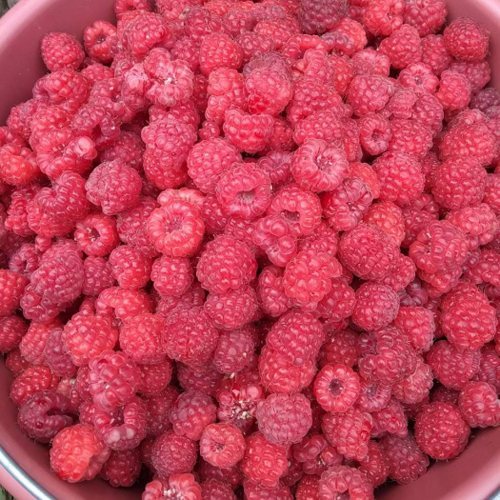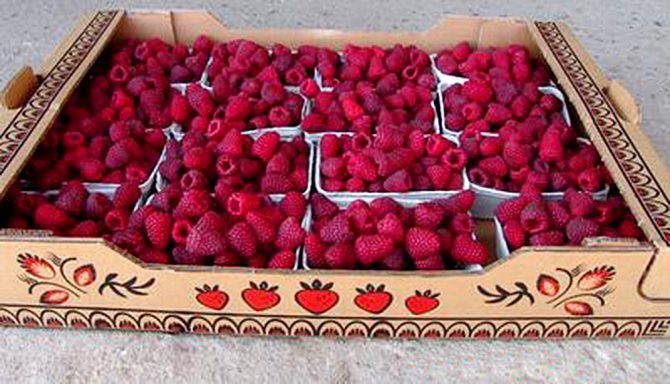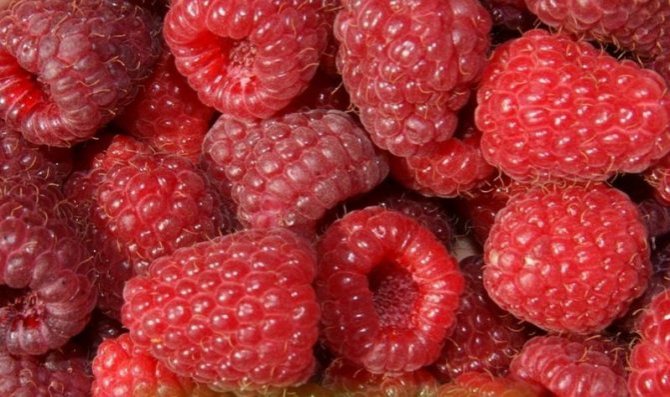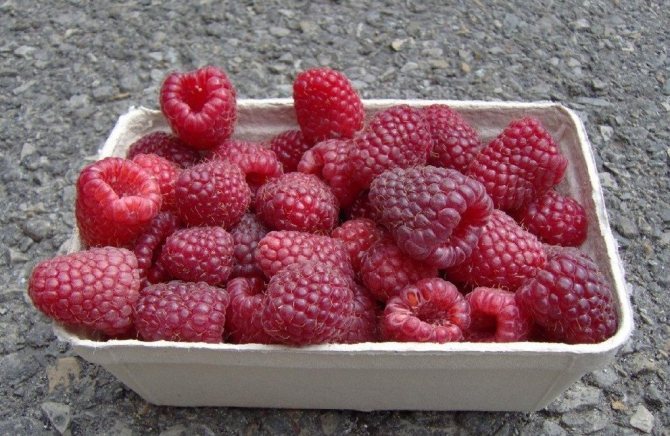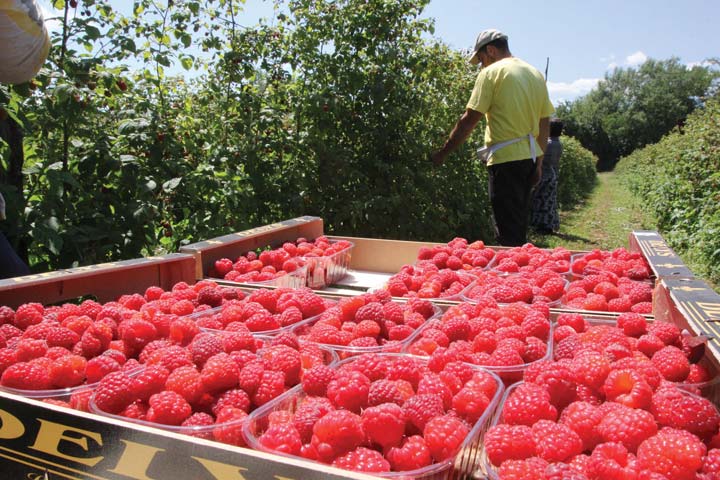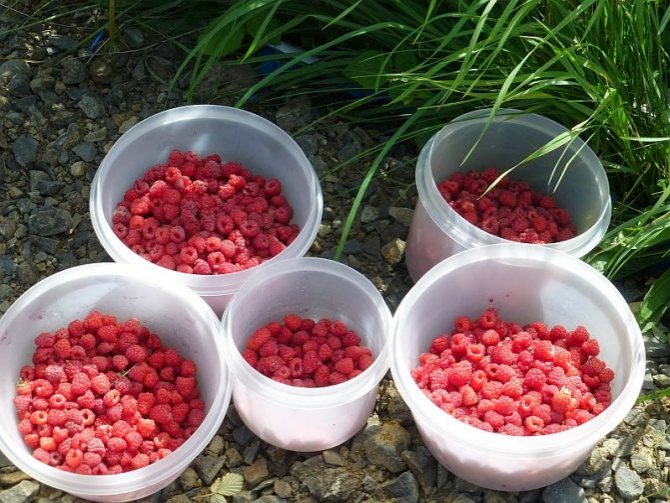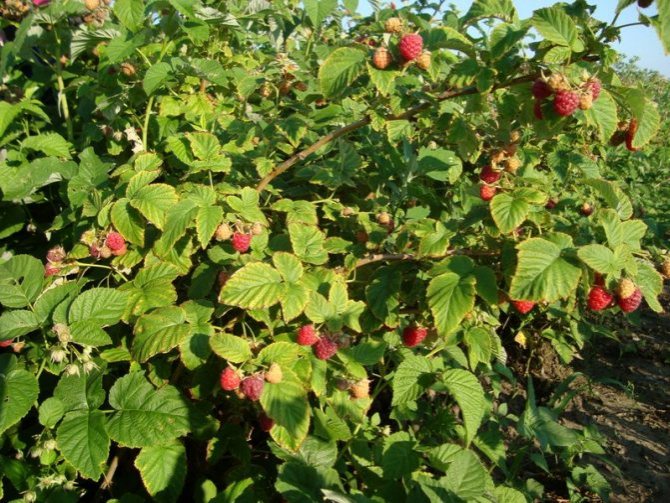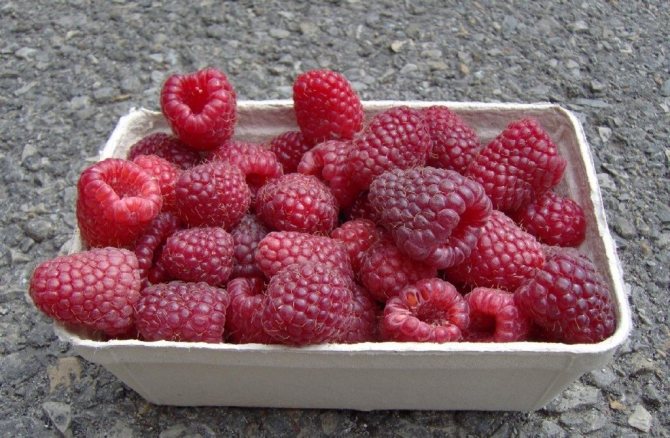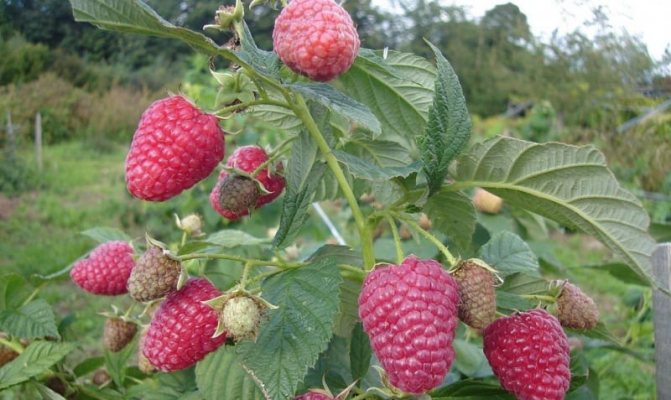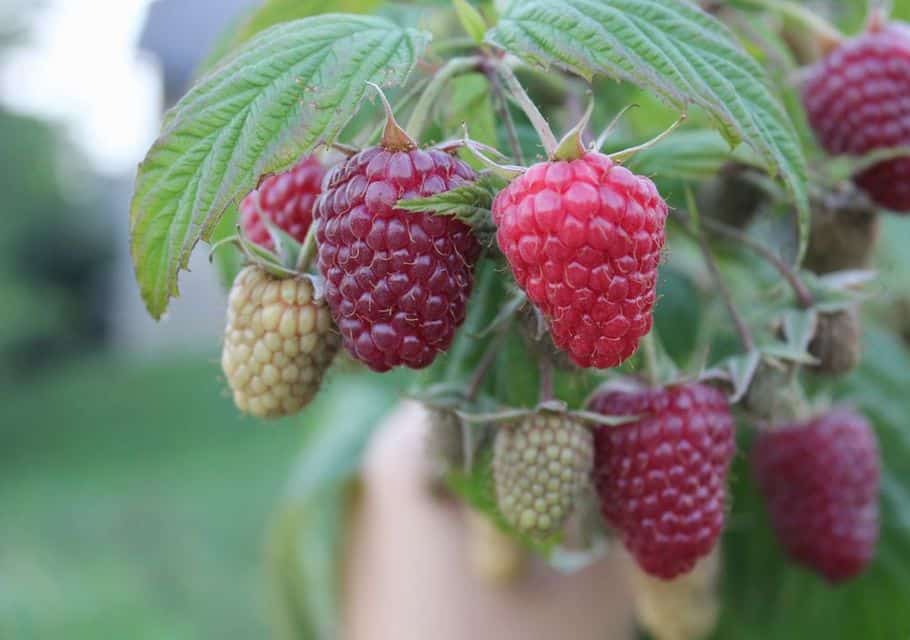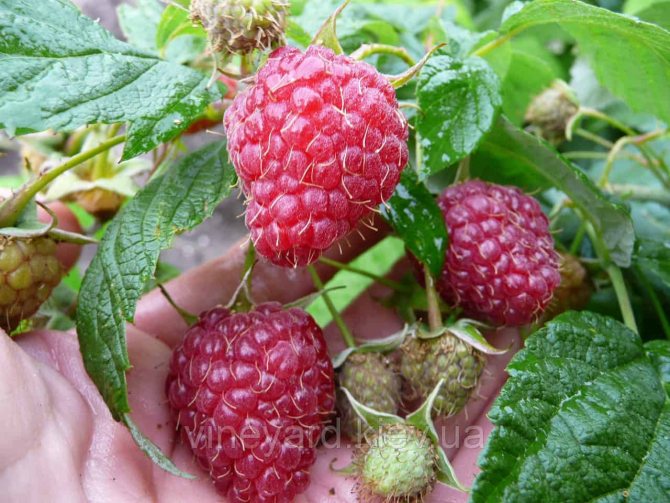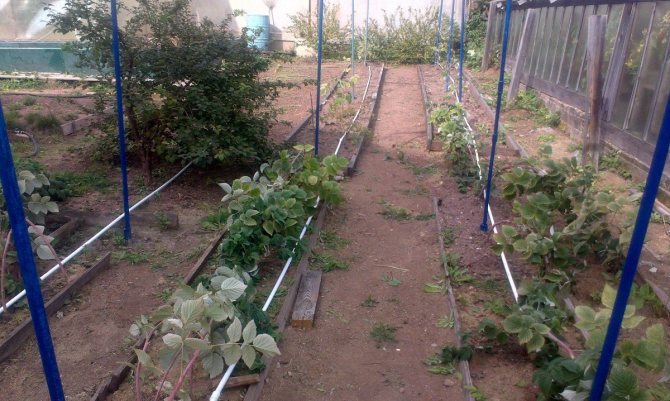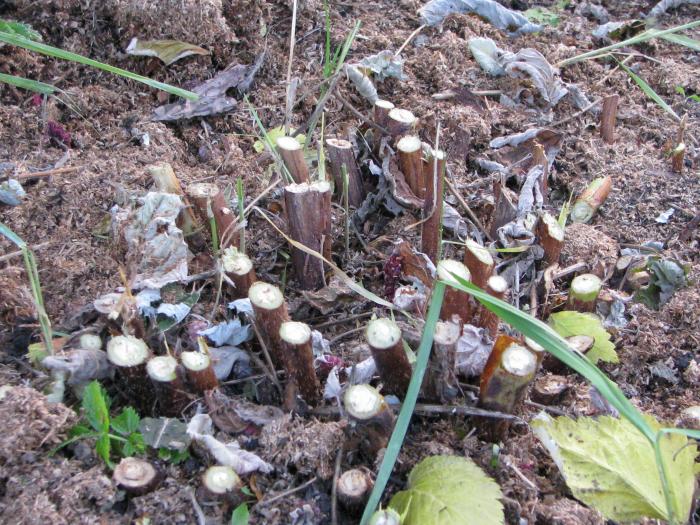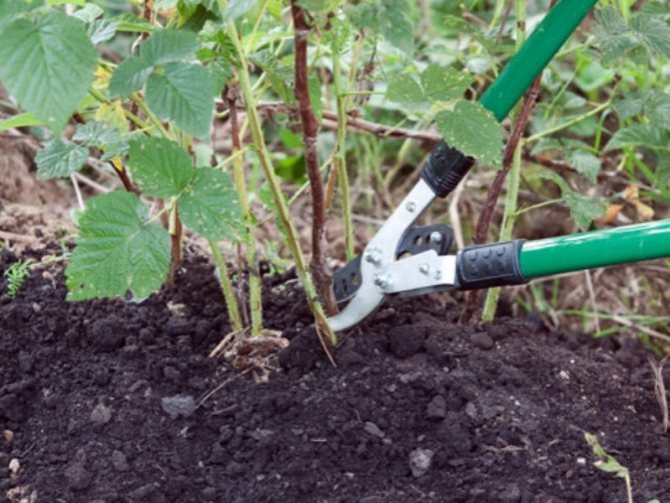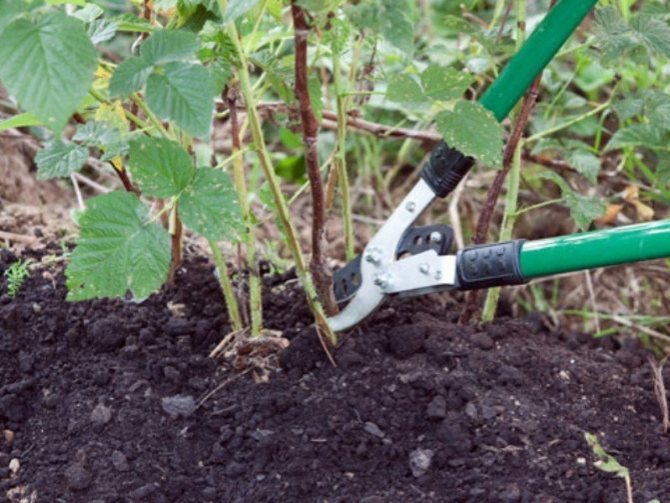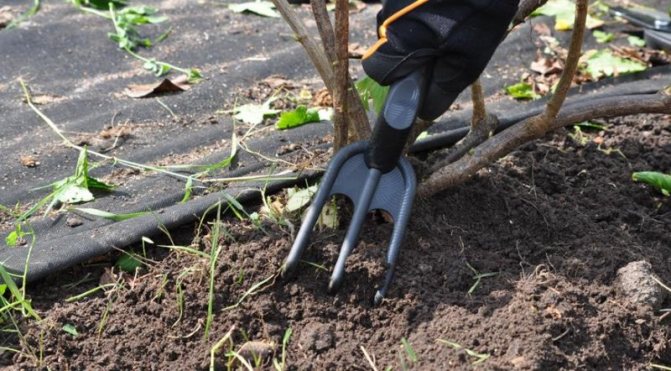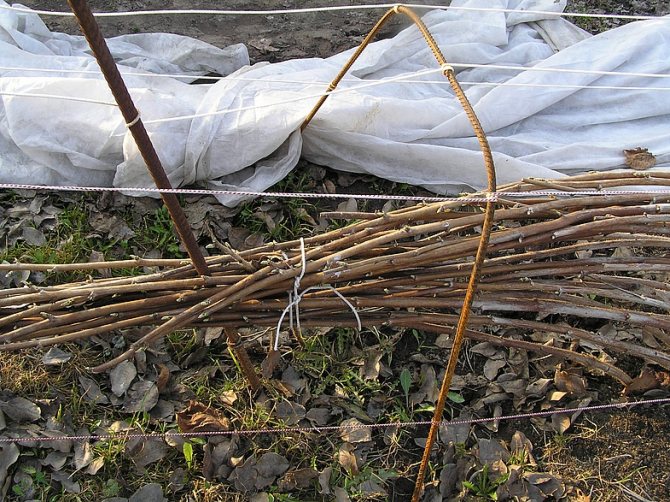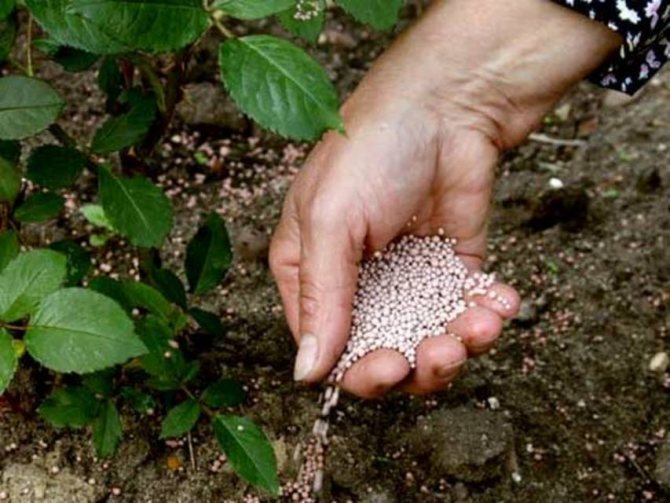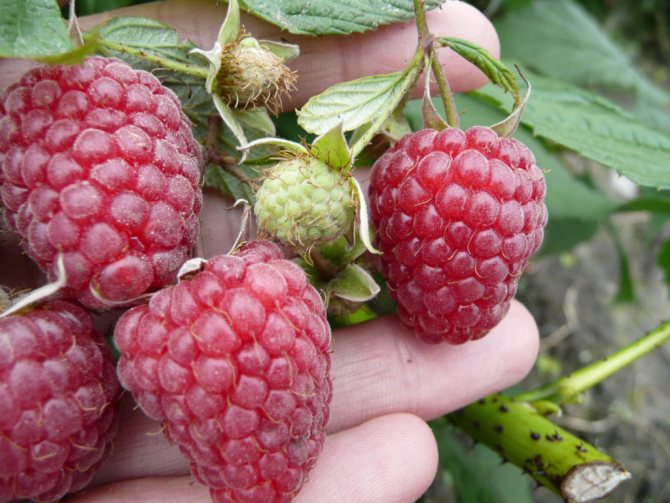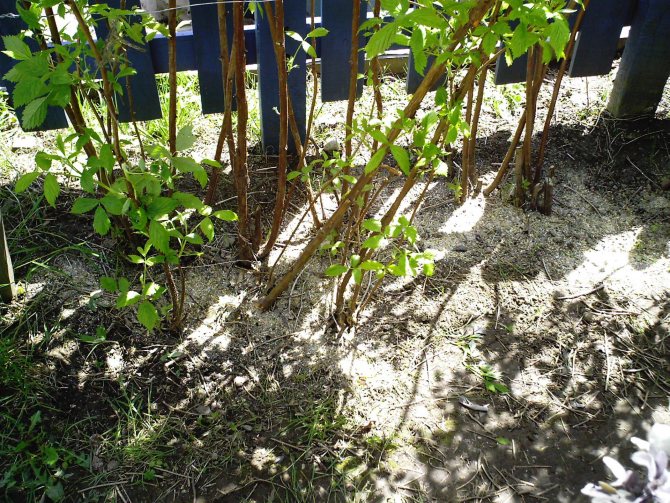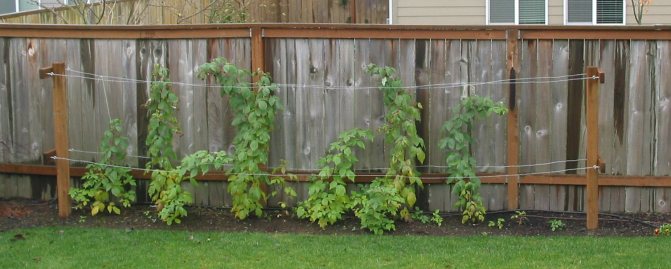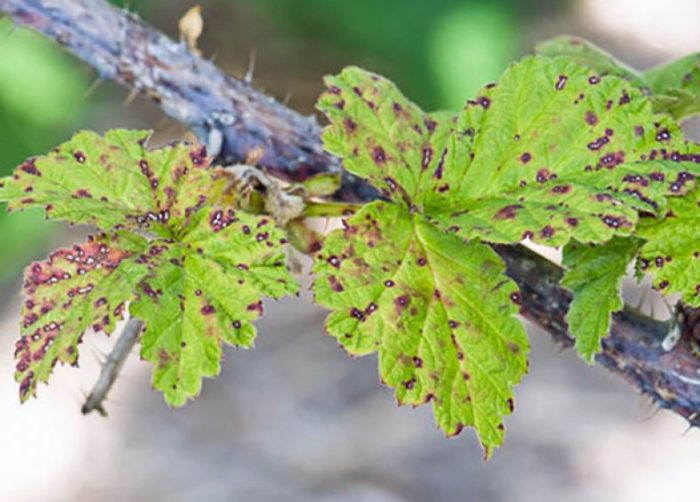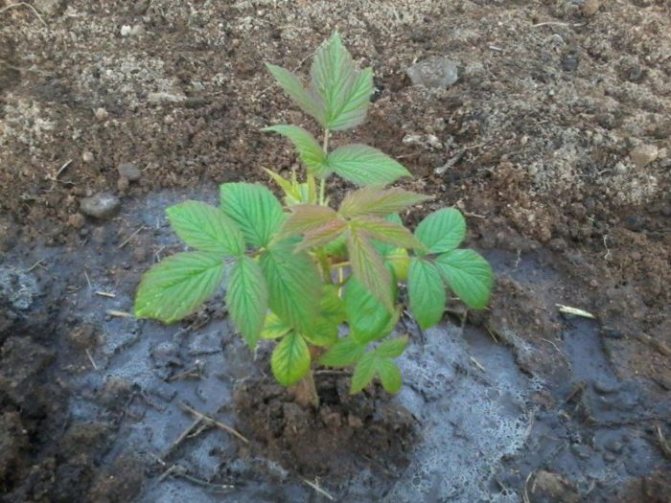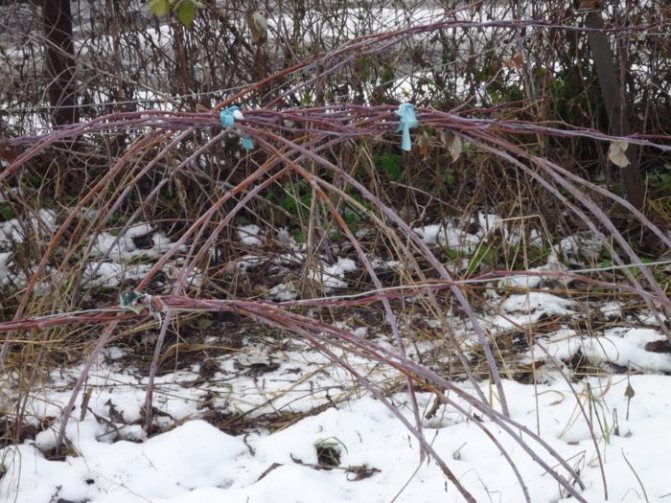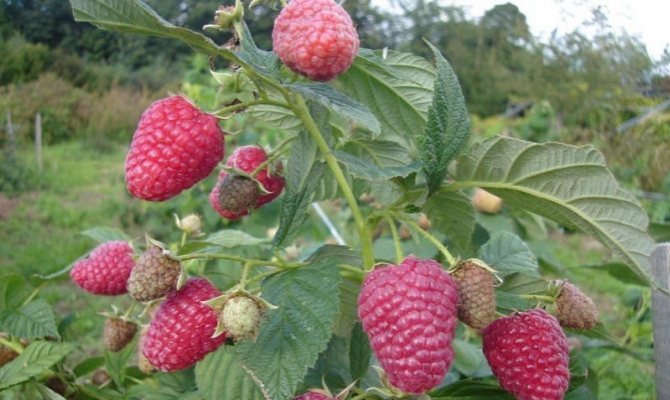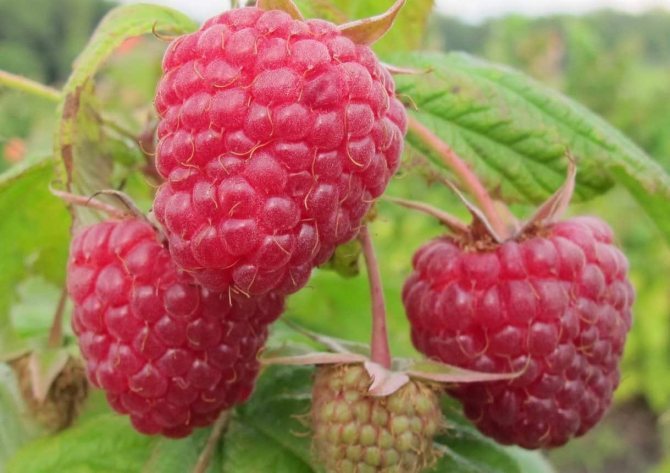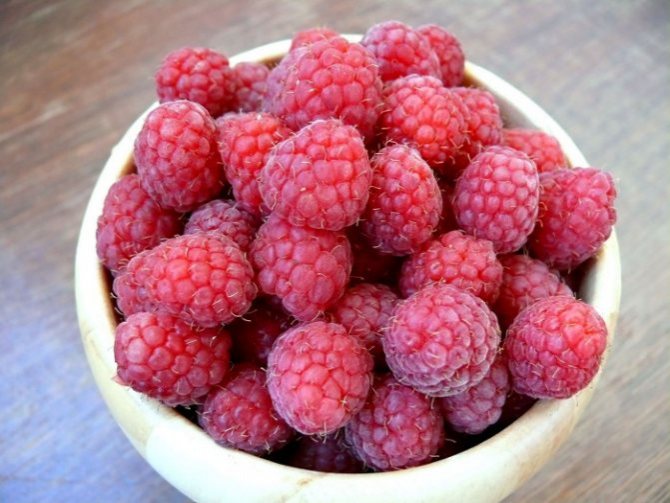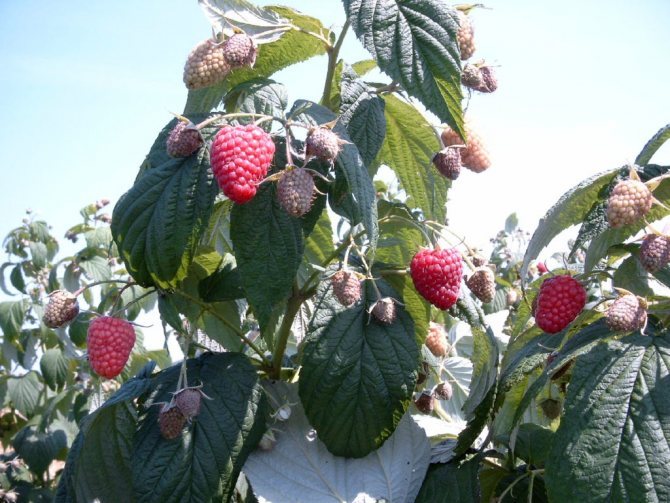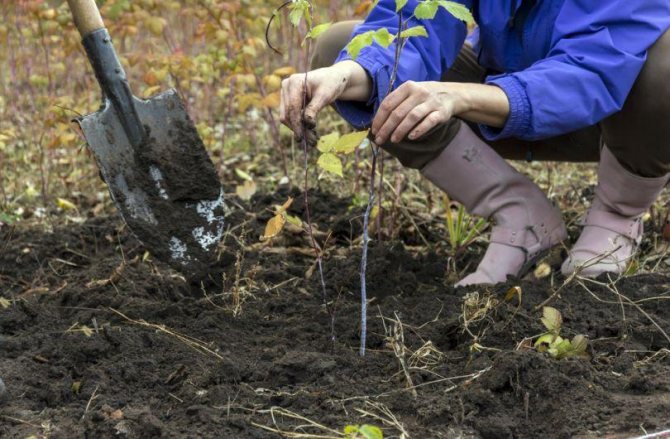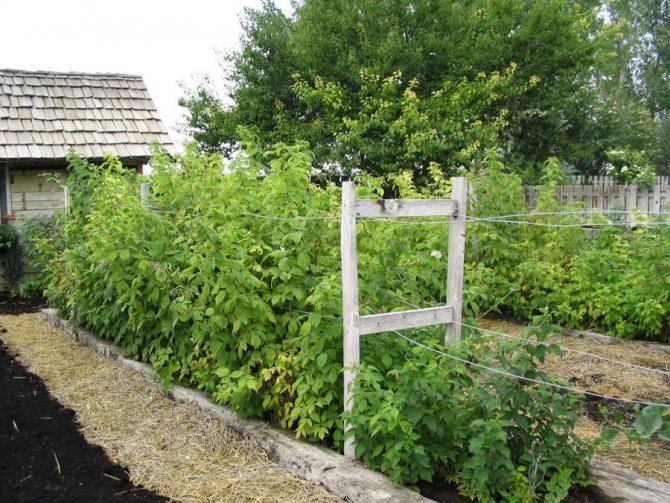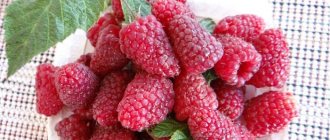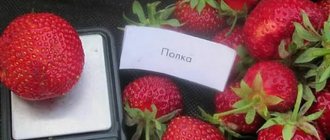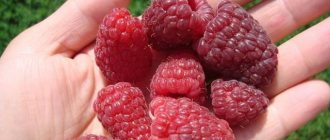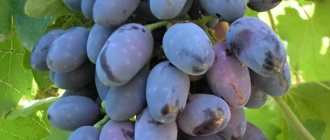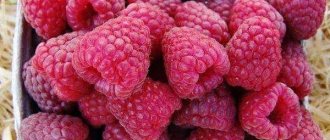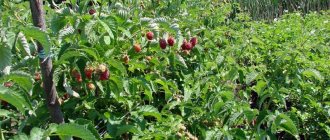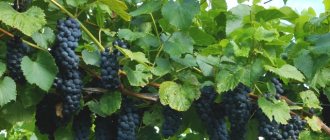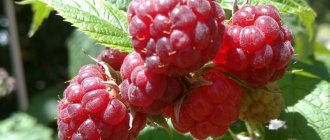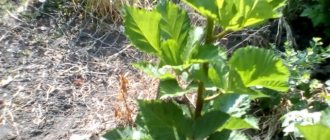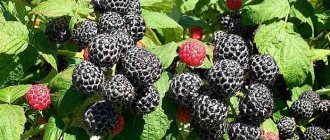Tatyana Panasenko Planted a new variety in the country
I have always grown different varieties of raspberries, which bear fruit on second-year shoots in the middle of summer. And now a new variety, Polka, has appeared in my raspberry field, which yields a crop on annual shoots from August to the very frost. Late fruits are not susceptible to diseases and pests, they are distinguished by large berries suitable for transportation, which are highly valued on the market in autumn.
Description and characteristics of the remontant raspberry Polka (Polka): rules of care and reproduction
Raspberry Polka occupies the largest part of the planting among all varieties grown on an industrial scale in the European agrarian business. This hybrid was created by breeders specifically for the industrial production of berries. But if you follow the recommendations for growing raspberries, Polka demonstrates its varietal advantages in amateur gardening.
Characteristics of Raspberry Polka
The repaired variety, with proper care, shows record results - a yield of up to 7 kg per bush and a berry weight of about 15 g. The variety was bred in 1993 by the famous Polish breeder J. Danek.
It is a medium-ripening raspberry with the following characteristics:
- The bushes are medium spreading, 150-180 cm high.
- Shoots are strong, rich green, with a bluish bloom and few thorns.
- The root system is fibrous, gives a few shoots, due to this it does not grow in all directions.
- Berry ovaries are formed on annual and biennial branches. On the shoots of the first year, the fruits ripen from mid-August, on biennials - from the first decade of July.
- The berries are large, elongated-conical, deep red or burgundy, depending on the degree of ripeness. Fruit taste, sweet with barely noticeable sourness. A cultural aroma.
Advantages and disadvantages
Raspberry polka has many benefits:
- large, perfect shape and sufficient density berries;
- extended period of fruiting;
- resistance to most diseases characteristic of the culture;
- high productivity;
- limited overgrowth formation;
- a slight stiffness of the shoots.
The disadvantages of the variety are considered intolerance to sudden changes in temperature and poor resistance to heat.
Planting a remontant variety Polka
Compliance with the rules for planting a shrub is an important condition for its development and maximum yield of fruits. The variety is grown in two ways:
- Kustov - in planting pits 40X40 cm, located at a distance of 1.5 m from each other.
- Private - in a trench 35 cm deep, with a gap of 2 m from each other. The distance between the bushes is 80-90 cm.
What kind of soil and place to choose?
The selection of the right site is an important condition for the successful development of the shrub and obtaining a rich harvest. The most comfortable conditions for growing a variety:
- Bright but soft lighting. It is good if a low tree with a sparse crown is located not far from the bush. In this case, the plant will have enough sun, and the berries will not suffer from the heat.
- Wind and draft protection. It is ideal to plant raspberries near blank fences, outbuildings, or on the south side of the house.
- For the roots, it is best to choose light loam.On more dense soils, before planting in the ground, add 2 buckets of coarse river sand per 1 m².
The nutrient content of the soil is increased by introducing the following substances per 1 m²:
- humus or compost - 2 buckets;
- superphosphate - 60 -70 g;
- potassium sulfate - 50 g;
- wood ash - 500 g.
When is the best time to plant?
For planting raspberries, periods are chosen when vegetative processes in the aboveground part of the seedlings are slowed down:
- in the spring, before the buds awaken, after the soil warms up to 15 ° C heat.
- in the fall, at the end of the ripening of the crop, 30-40 days before the onset of the first frost.
In the process of growing raspberries, traditional care measures are needed: watering and feeding, loosening and mulching the soil, pruning, protection from diseases and pests.
Frequency of watering and feeding
Adequate moisture is a basic requirement for plant care. Polka does not tolerate drought: the branches begin to dry out, and the berries become smaller. The soil should be moistened to a depth of 30-40 cm. Therefore, 2-3 buckets of water are poured under each bush.
Experienced gardeners prefer to moisturize raspberries by organizing drip systems. It is not necessary to purchase expensive options, it is enough to stretch a hose with holes to the bushes and turn on a weak water pressure for 1-2 hours every 1-2 weeks.
High yields with a long fruiting period ensure regular feeding. Fertilizers begin to be applied from the third year of the bush's life. Since the first 2 roots have enough nutrition introduced into the soil during planting.
The timing of fertilizing and the composition of fertilizers are as follows:
- In early spring, around mid-April, the soil under the bushes is spilled with chicken droppings or mullein.
- Before flowering and during the formation of berries, complex mineral fertilizers are applied with a sufficient amount of phosphorus and potassium. Wood ash is additionally poured into the aisles.
- In the fall, trunks are mulched with compost or humus.
Do you need pruning?
Experienced gardeners advise to grow Polka raspberries in an annual culture and carry out 2 pruning of shoots:
- In the summer, thin, weak branches are removed. For active fruiting and preservation of the large size of the berries, 6-7 shoots are left in each bush.
- In the fall, all raspberries are cut at the root. All removed stems are burned.
- To increase yields, you can use the Sobolev double pruning method.
How to prepare for winter?
The wintering of the bush is organized in two ways:
- With complete pruning of shoots, the soil is mulched with straw, peat or sawdust to protect the roots from freezing. Mulch is poured 2 weeks after digging the soil in the near-trunk circles by 7 cm, in the aisles - by 10-12 cm.
- To obtain a double harvest in spring, the tops of the shoots are pruned by 15-20 cm. In the fall, fruiting, dry and damaged branches are removed.
- If some of the shoots are left for the winter to trap snow, they are tied in a bundle and bent to the soil. Then the branches are fixed with a metal or wooden slingshot and covered with agrofibre or spruce branches.
Disease and pest control
The authors of the variety endowed it with resistance to many diseases characteristic of the culture. But the plant still retained its susceptibility to some ailments:
- Anthracnose - a fungal disease, manifested by the formation of purple spots on the leaves and shoots. The affected parts of the plant dry up and fall off. Spores of the fungus are destroyed by spraying the bush before flowering with Bordeaux liquid (3%).
- Verticillary wilting - one of the most dangerous fungal diseases. The pathogen affects the vessels of the plant and completely deprives the aerial part of nutrition. The infected bush begins to turn yellow and crumble. It is impossible to save the affected part of the plant. Therefore, with the extensive spread of the fungus, raspberries are uprooted and disposed of.
- Root cancer - a sign of the disease - growths on the root collar. The plant weakens due to impaired absorption of nutrients. The disease cannot be treated, so the bush will have to be dug up and burned.The only preventive measure for this pathology is the use of non-infected seedlings for planting.
In addition to diseases, insects can harm the bushes:
- aphid;
- spider mite;
- raspberry beetle;
- stem and shoot gall midge.
For the prevention and destruction of pests, insecticides are used: Karbofos, Aktara, Alatar, Fufanon. Processing can only be carried out before flowering. With later use, the poison accumulates in the fruit and becomes hazardous to health.
Reproduction methods: description with photo
The Polka variety forms a minimum number of root suckers, so they are not destroyed during the summer, but used for reproduction. Shoots are separated from the mother bush when their height reaches 20 cm.
When single root suckers are not enough, the cuttings rooting method is used for propagation. The process technology consists of the following stages:
- A developed semi-lignified shoot is chosen and divided into segments 15 cm long.
- The lower part of the workpiece is made oblique at an angle of 45 degrees. To stimulate the growth of roots, bark notches are made in the lower part.
- The stalk is placed in a container with water and the addition of a root formation stimulant: Heteroauxin, Kornevin.
- When filamentous roots 3-4 cm long grow on the handle, they are moved into the soil.
Gardeners reviews
Raspberry variety Polka (Polka)
Now in the world, and in our country, there is a huge number of remontant varieties of raspberries and every season more and more new ones appear. Someone embarks on endless experiments with these novelties, and someone from year to year does not change one or two proven "workhorses". Well, and some, and we think this is the most correct thing, do not abandon the old and proven, while gradually testing newcomers for "professional suitability." You can argue endlessly, but there are those varieties that become reference and with which others are compared according to various indicators, and are also used in breeding for breeding the same new products. And from year to year they bring their owners a good income and just the joy of owning them, generously endowing with delicious berries. One of these is the Polish repairman Polka.
History of creation
This remontant was obtained from a Polish institute called Sadowniczym Zakładzie Doświadczalnym Instytutu Sadownictwa i Kwiaciarstwa in Brzezno. It was bred by the world famous breeder Dr. Jan Danek in 1993, crossing raspberries Autumn Bliss, which by the way is also one of the parents of another reference remontant - Zyugana, and numbered grade P89 141. In the same institute, in subsequent years, it will be bred many other excellent varieties of raspberries.
Description
The regiment is the most common remontant in Poland, and probably one of the most widespread in the world, which has become a reference. He became the winner of various exhibitions more than once and was repeatedly recognized as the best. In many parts of Europe, it is grown under cover as a dessert berry. In Poland, it is mainly cultivated in an open field for mechanized harvesting using special berry harvesters. The variety is currently the EU standard for remontant varieties.
Raspberries bear fruit mainly on the shoots of the current year, so there is no point in leaving the stems for repeated summer fruiting. Ripening at Polka is one of the earliest in its class, slightly extended - from the end of July in the southern regions to November. In general, about three months. The plant is characterized by medium growth, the height of the stems is 1.5-1.8 meters. Shoots are compact, green with a bluish bloom, covered with small thorns. The leaves are oval, dark green, covered with fine hairs below. Shoot-forming ability is good, gives a lot of root growth, which is certainly a plus for growing seedlings, but requires extra effort when caring for plants.
Fruits are medium-large and large, even, elongated-conical, deep red, burgundy, shiny, dense, but with juicy refreshing pulp. May darken after collection. Drupes are small, well interconnected. One of the undisputed advantages of the Shelf is the excellent taste of berries, sweet, with a characteristic raspberry aroma.As the people who try it say - "the taste of raspberries from childhood." Brix tests showed that the share of sugar in fruits averages 11.7%, versus 10.3% for Tulamin berries, for example. The fruits are easily removed when picked, with a dry separation, when overripe, they do not crumble from the bush, in the main they are covered with leaves, but they can be baked in the summer sun. But they can withstand frosts of two to three degrees. The shelf has excellent transportability and keeping quality of the fruit; the berry does not flow during transportation. The variety is resistant to major raspberry diseases other than root cancer.
Interestingly, according to Jan Danek (the author of the variety), the average weight of the berries is 3.2-3.6 grams and the yield is 8-9 tons per hectare. And according to the results of tests of the experimental station in Tongeren (Belgium), the yield was 2.5 kg per bush and, accordingly, up to 20 t / ha indoors, subject to all the necessary growing conditions. And the average weight of fruits reaches 6.6 grams in the first samples. This data is provided by Hargreaves Plants, which has exclusive distribution rights since 2003 in the UK and many other countries, including North and South America. But already in the project of the Polish factory Malinowe in 2016, the harvest began on July 13. The average productivity of raspberries from 1 bush was 3.1 kg, and the total productivity was more than 25 t / ha.
And this is not fiction, there are a lot of berries hanging on the bush, gardeners in our country have an average weight of the Shelf berries of 5-6 grams. One of the conditions for achieving good results is regular provision of moisture, since the variety has problems with drought tolerance, and mulching of the root zone is also desirable. Plantations need to be exploited for an average of 5 years, a maximum of 7, then the productivity drops and there is a great danger of plant disease with root cancer, to which they are not at all resistant.
I would like to add one more thing - in our country, many people still confuse the names Polka (Polka) and Polana (Polyana), thinking that they are one and the same thing. These are completely different names for two different varieties. Polana is also a good raspberry, bred in Brzezno, more productive, but with much worse taste and a later ripening period.
So, to summarize, what causes such sympathy for our heroine all over the world? First of all, this is the ability to work productively in open ground conditions and early ripening. And of course, the excellent quality of the fruits, their size, sweetness and wonderful taste, good yield and excellent market indicators, plus relative simplicity in growing.
Raspberry variety Polka
Raspberry Polka is often referred to as the Shelf. It is a remontant variety known for its taste and rapid growth. Polka is grown practically throughout Europe and beyond. This is a promising type of raspberry that is suitable for both industrial cultivation and for growing on small, private land.
Description of the polka raspberry variety
The remontant raspberry Polka was created by a breeder from Poland, Jan Danek, by crossing the variety “O. This new variety was registered in 1993, and in 2003 it entered the mass market.
The bush is medium in height. The roots are fibrous. Shoots are even, strong, 1.5-1.8 meters long. Even during a big harvest, they do not sag under the weight, so support is not required. Fruit branches are formed on all internodes, on which 6-8 berries can ripen at the same time. There are thorns on the pagons, there are not many of them and they are quite soft, without hooks, but prickly, so it is recommended to care for the bushes and harvest in long rubber gloves.
Raspberry firm, medium juiciness, dessert, with a slight sourness, strong, pleasant smell
Berries are always formed on one-year and two-year pagons.On two-year-old branches, the fruits ripen from mid-summer, and on annuals - from the second half of August. The berries are large, conical in shape. Weight - 8-12 g. The color of berries after full ripening is almost burgundy or deep crimson, there may be a noticeable shine. Raspberry firm, medium juiciness, dessert, with a slight sourness. The smell is strong, pleasant.
Advantages of Raspberry Polka
Polka raspberries have a lot of positive qualities.
- The variety has good immunity to many diseases inherent in raspberries. It also tolerates pest attacks well.
- After ripening, the berries can be stored on the branches for a long time without crumbling.
- After picking, the berries lie for a long time without letting the juice.
- The commercial qualities are high. Raspberry Shelf gives big, beautiful berries, one to one. The color is rich, the aroma is strong.
- The berries are easily transported over long and short distances.
- The crop can be harvested by a mechanized or manual method.
- Productivity per bush - 4-6 kg.
- The taste is excellent, with a score of 5 out of 5.
Productivity per bush - 4-6 kg
Disadvantages of raspberries
Negative moments in cultivation, as much as one would like, cannot be avoided. Raspberry Polka has a lot of advantages, but it also has disadvantages.
- Average frost resistance. In cold regions, insulation is indispensable.
- The raspberry Polka can hardly endure heat and drought. Berries are fried in the sun, they can let juice, dry, lose their taste.
Features of planting raspberries Polka
Planting is an important point in growing any crop, including raspberries. If you plant it incorrectly or pick up a bad place, it will not be able to please with abundant harvests from year to year. The place for planting the Polka raspberry variety is chosen sunny or in partial shade. It is recommended to make manual props for the canopy in advance in order to darken the bushes from the scorching sun in hot summer. The land should be fertilized, not waterlogged.
Raspberry Regiment planting is carried out in spring or autumn. The variety quickly takes root, reacts well to recurrent and early frosts, the main thing is that the planting material is of high quality.
Raspberries of the Polka variety are propagated by root shoots or cuttings. Cuttings are cut in spring, summer, then notches are made on the bark on one side of the cutting and it is placed in the root solution. When roots appear on the handle, planting is carried out.
The place for planting the Polka raspberry variety is chosen sunny or in partial shade
If a shoot (shoot) is taken for planting, then it is cut off from the main bush in advance, the roots are soaked in a solution from pests, diseases, and only then they are used for planting.
Planting is carried out after fertilizing the soil. As a fertilizer, you can take compost, humus, superphosphate. For each cutting or bush, a separate hole is made, although sometimes raspberries are planted in trenches. The depth should not be very great, because the root collar is not buried. When the pits are made, water is poured into them, then cuttings or bushes are placed (preferably, at an angle of 45 degrees, but not necessarily). It remains only to sprinkle the roots with earth, compact with your hand and water well.
Culture care
Polka raspberry care is carried out from early spring to late autumn.
- The land around the bushes should always be clean, free of weeds, and loosened. If desired, you can mulch it to simplify work and reduce the number of waterings.
- Watering is carried out simple or drip. The second option is much more convenient, especially during a drought period - due to constant moisture, the earth will not dry out and it will be easier for plants to endure the hot summer.
- A garter is an optional part of grooming. If only a few bushes grow in the garden, you can not make supports, do not tie the bushes, they will grow upward, pagons rarely fall to the ground. However, in large plantings, a garter is recommended to make it easier to move between rows.
- Pruning of the Polka raspberry variety can be carried out 1-2 times a year.In the spring, remove those pagons that have been frozen over the winter or have signs of pest infestation. In autumn, old shoots are cut off, all damaged pagons. Some gardeners grow this remontant variety by renewing the bush every year. In the fall, they completely cut off all the pagons, leaving small stumps, and the next year the raspberries yield a rich harvest on the emerging, one-year branches.
- Top dressing is essential to maximize yields. If the land was fertilized during planting, then the first fertilizing is done from 3-4 years of cultivation. In the spring, around April - early May, mineral fertilizers with an abundance of nitrogen are applied. Before flowering and during the setting of berries, compost and wood ash are added. Of the minerals, potassium-phosphorus fertilizers are suitable. For the winter, once every 2 years, humus is introduced for digging.
Watering is carried out simple or drip
Once the crop is ripe, it can be harvested. In summer, as well as in autumn, there is no shortage of harvest, but gardeners note that it is in autumn that raspberries give the largest and most delicious berries. After collecting this variety of raspberries, you can make preservation for the winter, desserts, pastries, juices. Berries are also suitable for freezing and drying. During processing, they retain many vitamins and minerals.
Reviews of the polka raspberry variety
Raspberries of the Polka variety are known to many gardeners, we suggest that you read the reviews of the people who grow it.
- Elena Stepanova: “Raspberry Polka chose according to reviews on the Internet and recommendations of neighbors. She planted the bushes in the spring, took root quickly. The variety is very good, fruitful, there are enough raspberries both for conservation and for food - the grandchildren are happy. The only problem is that those bushes that grow in the shade, and I have two of them, give not very sweet berries. "
- Sofia Bykova: “I grow raspberries for sale and for my family. The Polka variety fell in love with the fact that the berries are moderately juicy. They do not flow, but they are not dry either. The taste is perfect - sweetness and acidity in perfect harmony. Bushes grow quickly, you can completely cut off all branches in the fall, and next year the harvest will be large, which is convenient in cold regions. In general, I recommend it to everyone! "
- Maxim Chuiko: “The shelf is one of the best types of raspberries. Ideal for sale. Even if you harvest in the evening, the berries look fresh in the morning, as if they had just come from a branch. The juice is not allowed during transportation, the taste is good, the aroma is amazing! But I noticed that if ripe berries are not picked on time and they fall under the rain, then the taste changes, it becomes somehow insipid. "
Disadvantages of the variety
Along with numerous advantages, the variety also has certain disadvantages:
- sensitivity to high temperatures and drought. With prolonged heat, the leaves may dry out and fall off, and the berries may “bake”. Plants have to be watered two to three times a week (at least 1.5-2 buckets per bush), if it is not possible to organize drip irrigation;
- low frost resistance. At air temperatures below -15 ℃, there is a high probability of freezing of the root system. Planting this raspberry requires careful mulching for the winter. Usually, a thick layer of peat, humus or dry plant residues acts as a mulch, but sometimes gardeners also use a non-woven covering material that allows air to pass through well and does not create stagnation of moisture at the roots;
- excessive "gluttony". Plants are very demanding on the content of basic nutrients (nitrogen, phosphorus and potassium) in the soil. Gardeners note that even if the recommended feeding regime is observed, the bushes after 3 years greatly deplete the soil, their productivity decreases, the berries become small and tasteless. European farmers familiar with this feature of the variety grow it by separating rows of mature plants from rows of young seedlings in order to be able to periodically "move" the fruiting part of the plantation;
- strong susceptibility to bacterial diseases of the root system (in particular, root cancer).Planting needs regular preventive treatments and control of the chemical composition of the soil, since the deficiency of some substances contributes to the multiplication of pathogens.
Harvesting
The fruits begin to ripen in late July or early August. The last crop is harvested at the end of September.
Ripening is non-simultaneous, so berries are picked in several stages. Raspberries are harvested by hand in small wooden baskets.
The average yield is 1.7–2 kg of berries per bush (10–12 tons per hectare). Under ideal growing conditions, 2–2.5 kg are harvested per bush and 18 tons per hectare.
Fresh berries are kept at temperatures from 0 to +4 degrees for 5-7 days. Instant freezing or drying is used for long-term storage. The fruits are transportable.
Raspberries are consumed fresh and used for processing in home cooking and in industrial conditions. Polka is used to prepare desserts, fillings for confectionery products, confiture, juice, and preserves.
Sweet berries with a slight sourness are eaten with pleasure by both children and adults.
Description
The regiment is the most common remontant in Poland, and probably one of the most widespread in the world, which has become a reference. He became the winner of various exhibitions more than once and was repeatedly recognized as the best. In many parts of Europe, it is grown under cover as a dessert berry. In Poland, it is mainly cultivated in an open field for mechanized harvesting using special berry harvesters. The variety is currently the EU standard for remontant varieties.
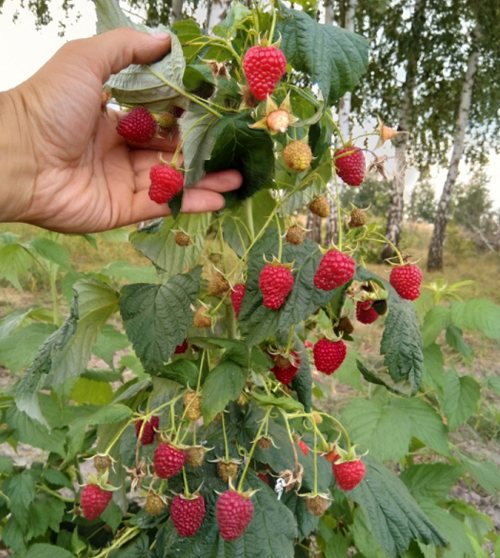
Raspberries bear fruit mainly on the shoots of the current year, so there is no point in leaving the stems for repeated summer fruiting. Ripening at Polka is one of the earliest in its class, slightly extended - from the end of July in the southern regions to November. In general, about three months. The plant is characterized by medium growth, the height of the stems is 1.5-1.8 meters. Shoots are compact, green with a bluish bloom, covered with small thorns. The leaves are oval, dark green, covered with fine hairs below. Shoot-forming ability is good, gives a lot of root growth, which is certainly a plus for growing seedlings, but requires extra effort when caring for plants.


Fruits are medium-large and large, even, elongated-conical, deep red, burgundy, shiny, dense, but with juicy refreshing pulp. May darken after collection. Drupes are small, well interconnected. One of the undisputed advantages of the Shelf is the excellent taste of berries, sweet, with a characteristic raspberry aroma. As the people who try it say - "the taste of raspberries from childhood." Brix tests showed that the share of sugar in fruits averages 11.7%, versus 10.3% for Tulamin berries, for example. The fruits are easily removed when picked, with a dry separation, when overripe, they do not crumble from the bush, mostly covered with leaves, but can be baked in the summer sun. But they can withstand frosts of two to three degrees. The shelf has excellent transportability and keeping quality of fruits; the berry does not flow during transportation. The variety is resistant to major raspberry diseases other than root cancer.
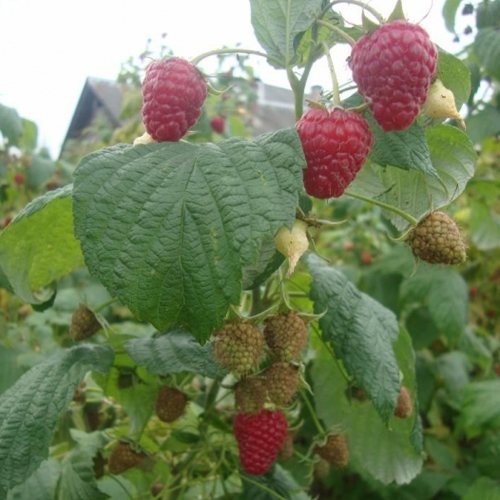

Interestingly, according to Jan Danek (the author of the variety), the average weight of the berries is 3.2-3.6 grams and the yield is 8-9 tons per hectare. And according to the results of tests of the experimental station in Tongeren (Belgium), the yield was 2.5 kg per bush and, accordingly, up to 20 t / ha in greenhouses, subject to all the necessary growing conditions. And the average weight of fruits reaches 6.6 grams in the first samples. This data is provided by Hargreaves Plants, which has exclusive distribution rights since 2003 in the UK and many other countries, including North and South America.But already in the project of the Polish factory Malinowe in 2016, the harvest began on July 13. The average productivity of raspberries from 1 bush was 3.1 kg, and the total productivity was more than 25 t / ha.
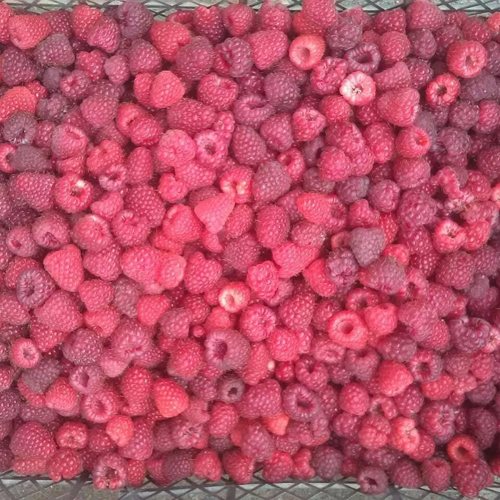

And this is not fiction, there are a lot of berries hanging on the bush, gardeners in our country have an average weight of the Shelf berries of 5-6 grams. One of the conditions for achieving good results is regular provision of moisture, since the variety has problems with drought tolerance, and mulching of the root zone is also desirable. Plantations need to be exploited for an average of 5 years, a maximum of 7, then the productivity drops and there is a great danger of plant disease with root cancer, to which they are not at all resistant.
I would like to add one more thing - in our country, many people still confuse the names Polka (Polka) and Polana (Polyana), thinking that they are one and the same thing. These are completely different names for two different varieties. Polana is also a good raspberry, bred in Brzezno, more productive, but with much worse taste and a later ripening period.
So, to summarize, what causes such sympathy for our heroine all over the world? First of all, this is the ability to work productively in open ground conditions and early ripening. And of course, the excellent quality of the fruits, their size, sweetness and wonderful taste, good yield and excellent market indicators, plus relative simplicity in growing.
Landing rules
Providing favorable conditions for Polka raspberries, you can count on a good harvest. The main thing is to follow the basic rules of landing.
Boarding time
Plants with open roots take root well in early spring before budding. The harvest in the first summer will not be rich, since the seedlings have not yet gained strength. It is better to plant Polka in the fall, it should be carried out several weeks before frost, so that the plant has time to take root, get used to the soil and harden before the onset of cold weather. You will learn about planting raspberries in spring from this article.
Reviews of those who grow raspberries Polka
Natalia, 45 years old, Moscow region: I grow Polka raspberries partly in a two-year mode, and partly the fruits appear on the shoots of the current year. As a result, we harvest the first harvest at the beginning of summer, and the fruits have a pleasant taste and are large in size. But the berries that appear in the fall are more sour and smaller. Probably, the bushes do not have enough light on the site. I will change the place for this raspberry for a more sunny one.
Tatyana, 50 years old, Volgograd region: Last season, the yield of the variety and the size of the berries simply shocked me - the large amount of rains that passed in summer and autumn affected me. But I would like to note that the shoots were not ready for a high harvest, so they bent heavily to the ground, it was necessary to urgently put supports under them. Next year I will definitely tie bushes to trellises.
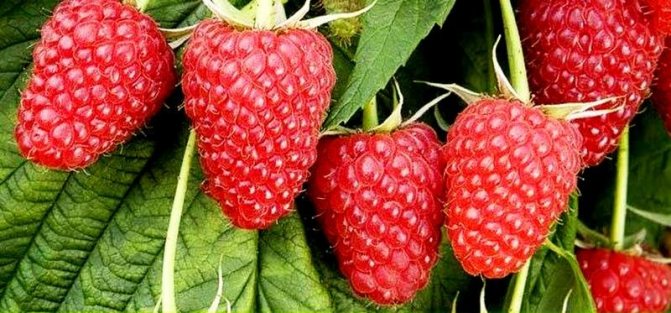

With the right choice of a planting site and good further care, the Raspberry Regiment will bear fruit several times per season, giving a large number of tasty large berries from each bush.
Characteristics of the variety
Raspberry polka is a medium-sized shrub up to 1.8 m high. The average height of this variety is 1.5 m. Up to 10 shoots are formed on one seedling. The stems have soft thorns.
Ripening of berries begins early enough. The first crop of raspberries can be removed from new shoots at the end of July, and fruiting continues until the onset of frost. Compared to other varieties, the raspberry of the shelf starts fruit formation two weeks earlier and lasts for three months.
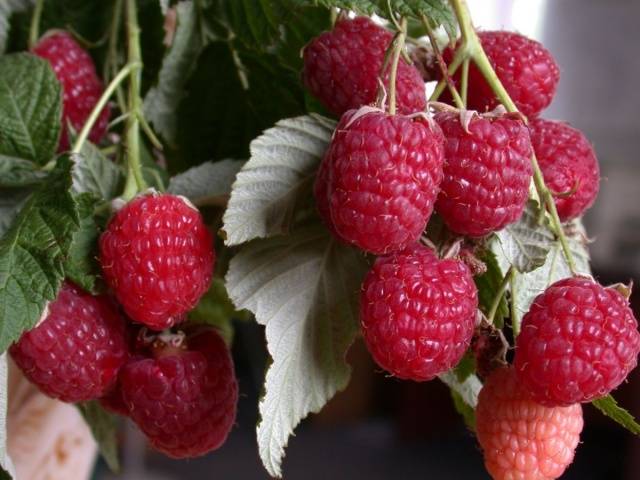

Attention! The berries are distinguished by a sweet taste with a slight sourness and a pronounced aroma.
The berries weigh about 3.6 g. With active feeding, they grow up to 6 g. As you can see in the photo, up to 10 conical fruits ripen on each brush. The drupe is small, practically not felt, and the raspberries themselves are quite juicy.
An important feature is the low winter hardiness of the variety. The raspberry shelf may not withstand severe frosts. Warming the root system for the winter will help to solve the problem.
Plant in spring or fall
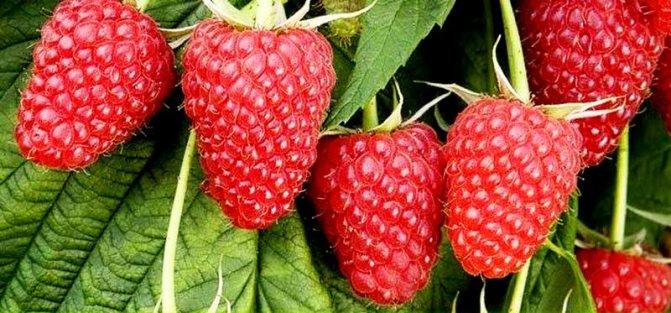

An attractive large berry weighing up to 15 g with a long fruiting period. Photo: Malina Polka:
- Remontant raspberry Polka (lat.Rubus idaeus remontant) differs not only in a bountiful harvest, but also in huge berries that are hidden under the leaf. Bushes are low, erect. The stems are thick and strong, but grow best on trellises. Lateral shoots are formed on each stem, on which large fruits grow. The root system is powerful, forms many shoots with few thorns.
- Dessert-type berries, round or cone-shaped... Bright, red fruits are quite attractive, aromatic, unsurpassed in taste. The berries remain on the bush for a long time, do not flow, do not fall off, and are suitable for long-term transportation. The drupes are quite tightly adjacent to each other, which does not allow the berry to spread, the seeds are small, practically not felt when eaten. The taste is sweet with a slight sourness, which gives the berry a spice.
- The disadvantages include a weak growth of replacement shoots, which affects the difficulty of reproduction. Weak frost resistance and lack of immunity to high temperatures, makes raspberries of limited use. It is difficult to grow in the southern and northern regions. Raspberries are prone to root diseases and need abundant feeding.
The author notes the high yield of raspberries up to 7 kg per bush and large-fruited berries up to 15 g.
Raspberry Polka Care
Raspberries of this type require special care, which must be done regularly. Otherwise, the fertility of the plant will be low.
Watering
The plant requires constant watering. The heat has a bad effect on berries and yields. On hot days, the fruits are baked, they begin to dry, the greens wither. For good growth and fertility, soil moisture at a depth of 30 cm should be at least 75%.
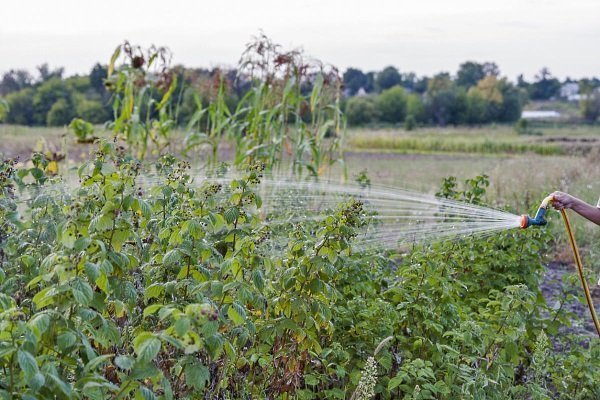

When the humidity decreases, the plants are watered every 7 days. At the beginning of autumn (if there is no rainfall), it is required to water raspberries at the rate of 20 liters per bush.
If the humidity exceeds 80%, this is bad for this type of raspberry. The water remaining in the hole blocks the access of oxygen to the root system, the leaves turn yellow. You should not water the bushes for a period of time and loosen the soil.
Watering types:
- Sprinkler - Water is sprayed from a hose or sprinkler. The option is advised to use in dry weather: watering irrigates the bush itself and increases the humidity of the air. Sprinkling is not recommended during the period of fruit ripening.
- Furrow irrigation - in this case, the water is mixed with fertilizers. Before irrigation, grooves are dug through which the liquid flows. After watering, the trenches are buried.
- Drip irrigation is the best irrigation option. Holes are made in the pipes along the bushes, through which water is supplied under pressure directly to the roots. Consequently, the humidity always remains at the same level, which is why fertility increases by 35%. This type of irrigation provides for an automated installation (convenient for large areas).
Wet soil should be loosened to avoid crusting. In order not to touch the roots when loosening, it is required to perform the operation not deeply (about 7 cm).
If the planting site is in an area with low humidity, cover the soil with mulch. It retains moisture in the ground, preventing it from evaporating. Mainly covered with straw, onion husks.
Weeding
It is necessary to weed the shrub regularly, nettles and other weeds draw out the nutrients necessary for raspberries from the soil, block the sun. You need to rinse gently without damaging the root system. If young shoots of the plant appear between the bushes, they must be removed.A strong blockage of the site is not desirable, as it negatively affects the yield.
Top dressing
For an optimal balance of nutrients, the shrub needs feeding.
How to determine what the plant is missing:
- the leaves began to turn yellow for no reason - there is not enough nitrogen;
- unnatural dark green color of stems and leaves - the level of phosphorus has decreased;
- rounded leaves and dark border - lack of potassium.
In the spring during the growth period, raspberries are fed with urea (30 g per 1 sq. M). In feeding, cow dung or chicken manure with water is used (1:10 or 1:20, respectively).
Top dressing, which contains nitrogen, increases the acidity of the soil, Polka does not like this. To adjust the acidity, you need to sprinkle the soil with ash.
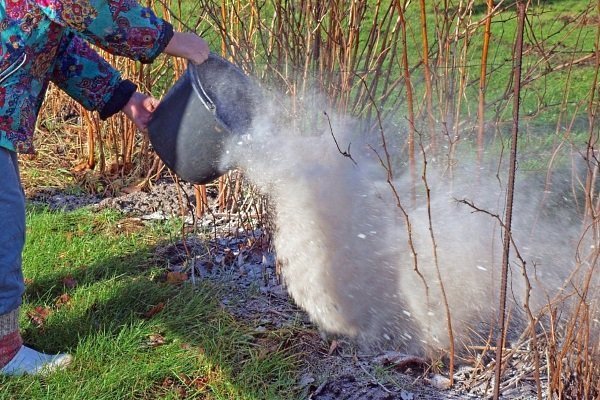

Polka has a negative attitude towards chlorine. The presence of this substance can cause a disease such as chlorosis.
When the first berries appear, you can water the shrub with organic fertilizers - infusion of nettle and onion peel. Nettle must be finely chopped, put in a container with water and left for 7-10 days. Then strain the infusion and dilute with water 1:10. A composition is also prepared from onion peels (0.5 kg per 10 liters).
Garter
This variety of raspberries does not need a garter or additional support. It happens that a lot of berries have appeared on the bush, then the stem will tend to the ground. In this case, you can make a garter.
At a distance of 20 cm from the bush, a column is carefully driven in without damaging the root system. The stem is tied in several places so as not to damage the bark.
Some gardeners use a net for linear planting. Stakes are driven in from both sides of the strip and a wire or mesh is tied between them in several rows. As they grow, the shoots are fixed to the net.
Reproduction
There are several options for propagating a culture:
- Seeds - this type is acceptable for breeders, as the process takes a long time.
- Green cuttings - in June, young shoots are cut (at an angle of 45 degrees). Then they are transplanted into a place prepared for seedlings. In two weeks, the sprouts will revive in moist soil. Closer to autumn, young shoots are transplanted into a raspberry tree.
- Root cuttings - in September, the roots are dug up, cut into pieces (10 cm) and buried in moist soil. Cover with mulch and spruce branches. The place is covered with a film, which is removed in the spring after the emergence of shoots. The shoots are grown in season and by autumn they are transplanted into raspberries.
- Division of the bush - the bush is dug up by the root, divided into several elements and transplanted into separate holes. The tops of the stems are cut off so that side branches appear.
Pruning and wintering
At the end of October, the entire aerial part of the raspberry is cut off (there should be 3 cm from the stem). This method will help protect the bushes from frost, have a beneficial effect on the fertility of the plant, and protect the culture from pests.
Read our article on how to properly prune raspberries in the fall.
If you leave only young growth, removing old trunks, the yield will be lower (the bush will not develop evenly). The remaining shoots and stumps are covered so that the culture does not freeze in frost.
In the spring, before the buds begin to bloom, it is necessary to remove the frozen and broken stems. It is required to remove all unnecessary branches (leave up to 9 pieces on one trunk). Before flowering, the tops of the bush (15 cm) are removed, so the raspberries stop growing, which has a beneficial effect on the yield.
Basic rules of care
The basic rules for caring for remontant raspberries Polka include feeding, pruning, watering, loosening, garter, shelter for the winter. The more carefully the rules of care are followed, the larger and better the harvest is.
Top dressing
The Polka variety needs abundant feeding. For full development and obtaining high yields, the plant requires a large amount of nutrients.If they are not enough, raspberries weaken, the quality of the fruits deteriorates, eventually the soil under the bushes will be depleted, and the plantings will die. To prevent this from happening, Polka needs to be fed for almost the entire season.
In the spring, as soon as the plants grow, apply a complex fertilizer in a dry form. It can be nitroammofosk or azofosk, which should be scattered in rows of 100–120 g per meter of planting (for young plants, the rate is reduced by half). After applying the fertilizer, immediately rake it into the soil to prevent nitrogen weathering.
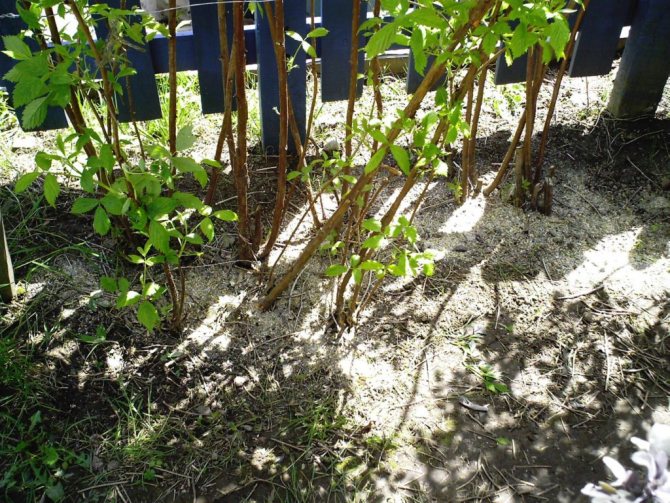

In the spring, dry mineral fertilizers are applied under raspberries
In the summer, after flowering and the first harvest, you can repeat the spring feeding option, but the best results will be when using solutions of cow manure (1:10) or poultry manure (1:25). Pour a bucket of liquid under one plant.
In autumn, in late September - early October, raspberries do not need nitrogen, which regulates growth processes, but they need phosphorus and potassium, which strengthen the root system and frost resistance. During this period, it is advisable to add superphosphate and potassium chloride in the amount recommended by the instructions for use. The last fertilization of the season should be done in preparation for winter. Pour manure or compost on a running meter of plantings.
Pruning
The main work on pruning raspberries is carried out in the fall, after harvest and leaf fall. At this time, you need to cut off the entire aerial part of the plant. This technique will allow Polka to endure the cold season without losses, there will be no reason to worry about freezing of the shoots. Young shoots that have appeared away from the main bush and which are not planned for further transplantation must be dug up and removed with a root.


In autumn, Polka is cut to the root
In the spring, when the shoots reach a height of 10–15 cm, thinning should be carried out: select 7–9 strongest shoots in the bush, remove the rest. If this is not done, the plantings will thicken, the shoots will be weakened, and the berries will become smaller, deteriorating their taste.
Watering
Raspberry Polka is demanding on the moisture content of the soil. Watering is carried out several times a season: before flowering, during ripening, after collecting the first berries and when preparing plants for winter. Of course, the number of irrigations is individual for different regions and they need to be done, independently assessing the moisture content of the soil.
When watering a plant, consume 10–20 liters of water. This can be done in different ways: form holes around the bush and pour water there with buckets (it makes sense with a small number of plantings); dig grooves 30 cm in both directions from the center of the row and let moisture through them (very high fluid consumption); use drip irrigation (most preferable for a large number of plants). After watering, fill up all holes and irrigation ditches.


Drip irrigation is the most economical and efficient method of irrigating raspberries
Loosening
Loosening must be carried out in order to prevent the appearance of weeds, improve the air permeability of the soil. This should be done carefully, to a depth of 5–7 cm, so as not to damage the plant roots. This procedure is also called dry irrigation, as it retains soil moisture.
Garter plants
Polka stems are quite powerful and, as a rule, do not require a garter, but for a more compact arrangement of bushes they can be tied to a trellis. The wire is pulled in two or three rows between special pillars to a height of up to 1.5 m.


Trellis - a must-have attribute of a raspberry plantation
Shelter for the winter
For the onset of cold weather, Polka raspberries must be properly prepared. These works, in order of sequence, can be presented as follows:
- Pruning.
- Cleaning of fallen leaves and weeds.
- Fertilizer.
- Loosening.
- Watering.
- Mulching the soil.
It is better to use chopped straw or sawdust (shavings) of deciduous trees as mulch. The mulch layer should be about 15 cm.In the spring, it can be mixed with the ground, it will become an additional fertilizer for plants.
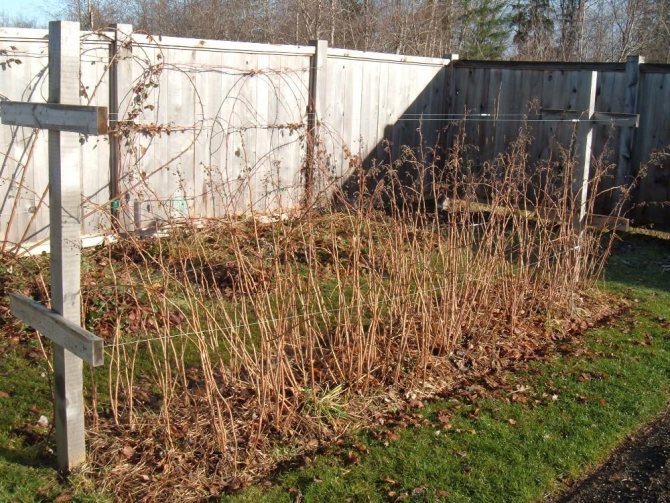

For mulching, you can use straw, sawdust, shavings
Diseases and pests
Since this variety of raspberries is completely mowed before wintering, pests rarely disturb the plants. But in unfavorable soil, the root system of this variety can get sick.
Diseases:
- Root cancer - tumors form on the roots, the bush withers, fertility decreases. Bacteria can appear in soil or humus. For prevention, you should not grow raspberries in one place, you also need to disinfect the roots before planting. For treatment, it is necessary to cut off the tumors and process the cut sites with a 1% solution of copper sulfate or completely dig out the plant.
- Vertical wilt - the roots crack, the leaves turn yellow and fall off, the berries become small. For treatment, treat the affected area with a 0.2% solution of Vitaros or Fundazol.
- Root rot - greens at the roots become stained, the leaves turn brown, the roots rot. For treatment, you need to destroy the bushes, treat the raspberries with a special fungicide solution.
Pests:
- May beetle - Water the plants with manganese or pull the beetles out by hand.
- Raspberry moth - spray the bushes with lime (1 kg per 10 l) until the buds appear.
- Aphids - it is necessary to wash off insects under running water.
Testimonials


Victoria S: “I really love this variety of raspberries, I planted it as usual, watered it, but didn’t fertilize it. The result exceeded my expectations, I collected a lot of berries during the season. I recommend this variety to everyone, and you can eat it until frost. "
Evgeny P: “I am very grateful to the breeders, for such a variety it is a miracle! My family also loves berries very much, they ripen quickly in the sun, dense, fleshy flesh. We planted it two years ago, but now, we don't know what to do with it, it bears a lot of fruit ”.
Vasily B: “Good grade, correct, it lies for a long time. The main thing does not rot like other varieties. I bought seedlings for a long time, since I planted it, I did not believe that they would take root, since the roots were slightly damaged. All is well, my fruits survived, I'm glad. "
Advantages and disadvantages
Raspberry polka has many benefits:
- large, perfect shape and sufficient density berries;
- extended period of fruiting;
- resistance to most diseases characteristic of the culture;
- high productivity;
- limited overgrowth formation;
- a slight stiffness of the shoots.
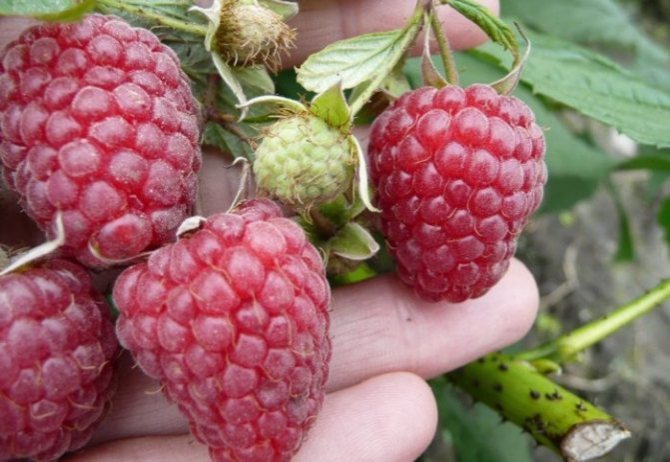

The disadvantages of the variety are considered intolerance to sudden changes in temperature and poor resistance to heat.
Important! The variety is prone to diseases of the root system due to waterlogging and exposure to low temperatures. Therefore, when growing Polka in regions with a harsh climate, it is necessary to pay maximum attention to the plant and follow the recommendations of specialists for preparing for winter.
Growing and care
Watering
Considering the long fruiting period, as well as the fact that the Polka raspberry does not tolerate drought well, it is advisable to dig irrigation grooves in the raspberry grove along the rows or equip drip irrigation so that the soil is constantly moistened 30-40 cm deep.
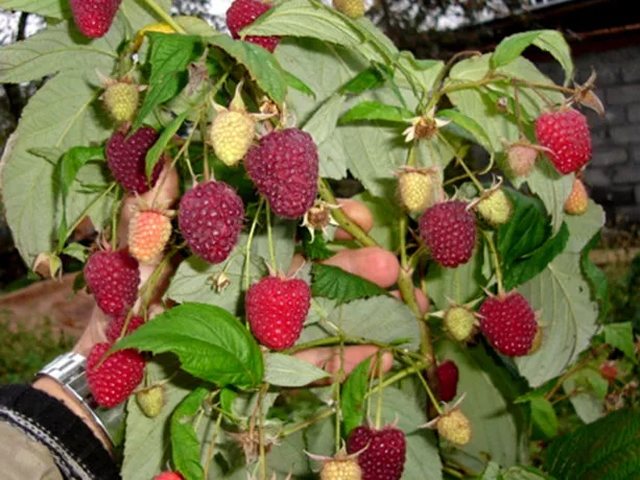

Pruning
Gardeners who have been breeding Polka raspberries for many years recommend growing it in an annual crop, when all the shoots are cut off at the root before winter. After trimming, they must be burned. In summer, if the bush grows strongly, then you need to cut out thin, weak stems, leave 4-6 healthy, strong shoots for fruiting.
Top dressing
High yield, long fruiting period of the Polka variety require regular top dressing of the soil in the raspberry tree. If the site and planting trenches were fertilized before planting, then you can start feeding it regularly after 3-4 years. In April, for the growth of the bush, manure or chicken droppings, humus are introduced.
Before flowering, as well as in summer, when berries begin to set and grow, compost, herbal infusions, wood ash or complex mineral fertilizers containing potassium salt and superphosphate are applied.
Nitrogen fertilizers are not applied in autumn.
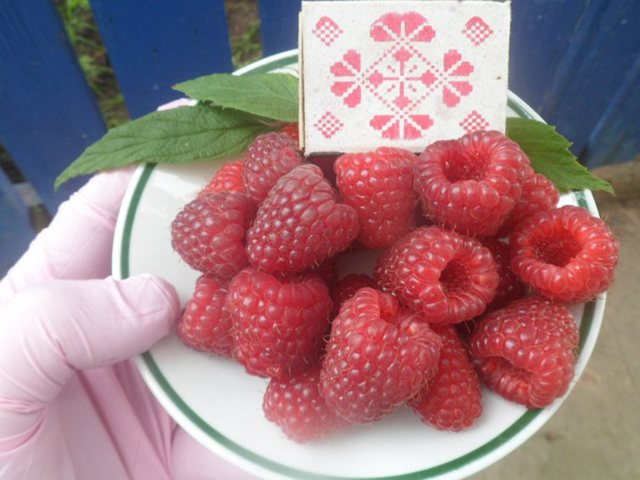

Preparing for winter
If for the winter the entire ground part of the shrub is cut off, then it is enough to cover the rows with straw, sawdust or high-moor peat. If some of the shoots are left until the next season, then they are collected in bunches, bent to the ground, strengthened, covered with geotextiles or any dense material.
Reproduction
Raspberry Polka gives little root growth, so it is not weeded out, but separated from the main roots and transplanted to the right place. If there are not enough offspring, then cuttings are grown for reproduction. A part of the shoot is cut out, longitudinal notches of the bark are made in the lower part of the cuttings and placed in a solution with a root. When filamentous roots are formed at the end of the cutting, it is transplanted into a greenhouse or in the shade under a jar. The next year, the rooted and strengthened seedling is transplanted to a permanent place.


Gardeners reviews
★★★★★ Natalia, 35 years old, amateur gardener, Chelyabinsk. I planted a variety on the advice of a friend. Didn't really do anything, just water it during a drought. In the first year, I harvested 4 buckets of the crop. ★★★★★ Svetlana, 62 years old, lives in a village, Moscow region. I love raspberries Polka very much - juicy and tasty! Grandchildren come, so they just can't be torn from the bushes. Everyone has enough and remains for jam. ★★★★★ Nikolay, 44 years old, summer resident, Moscow. I am not a fan of gardening, but this berry does not require special care. Basically just watering and cutting back in the fall. But the harvest in this situation turns out to be good. We pick berries after a little frost. Hide
Add your review
Raspberry Polka will certainly give a good harvest if it is provided with quality care. It is necessary to follow all the rules of planting, protection from diseases and pests, and also to harvest on time.
0
Breeding history
A new fruit crop variety was bred by crossing the Autumn Bliss raspberry and Polish breeders with prototypes. The main work was carried out by scientists in the early 90s of the last century. As a result of the experiments, a completely new variety of raspberries was obtained, which was given the name Polka. The fruit culture received not only the unique properties of frost resistance and natural immunity to diseases and pests, but also a stunning appearance of giant, beautiful and tasty berries.
For the first time, the remontant variety of raspberries Polka was presented only 10 years after the completion of the work, at the world exhibition.
Reference! Raspberries of the Polka variety have gained immense popularity among farmers in European countries, where berry crops are cultivated on an industrial scale.
Growing history
Repaired Raspberry Polka is an achievement of Polish selection. The variety was obtained by Jan Danek in 1993 at the Brzezn Institute of Horticulture and Floriculture by pollination of Otm Bliss and the P89141 line. After testing, it was presented in 2003 at the international exhibition Fruit Focus in Berlin. Since then, Polka has been a leader among remontant varieties for industrial plantings in Poland, Great Britain and many other countries.
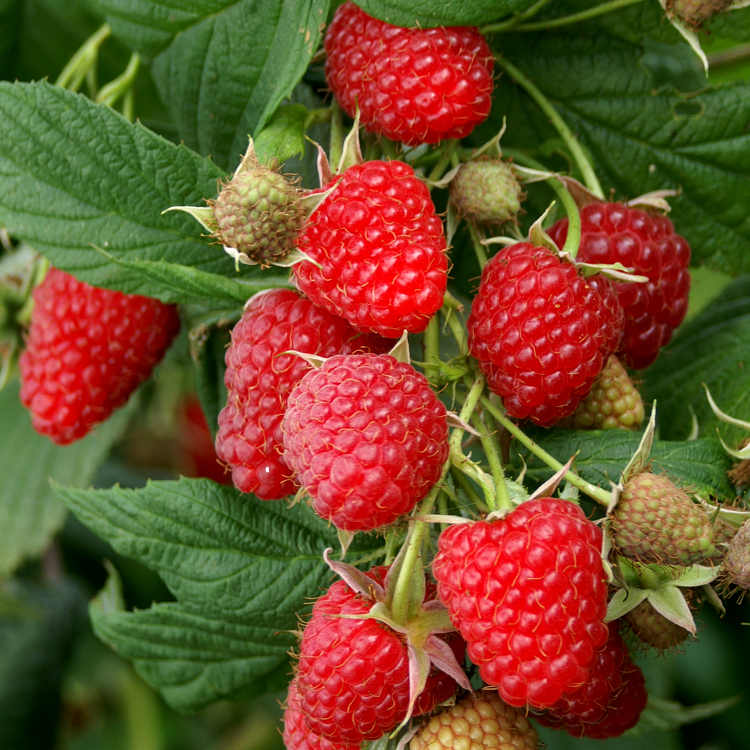

Raspberry Polka was bred by Polish breeders and for a quarter of a century has occupied a leading position in the berry market.
Description and photo of berries of this variety
Malina Polka (Polka) was bred in Poland in 1993. The variety received the status of the best European dessert variety.
The triumphal procession of Polka around the world took place after the international agricultural exhibition in 2003 "Fruit Focus".
The bushes of this variety are medium-sized, reaching a height of 1.5–1.7 m, one rhizome gives up to 10 shoots, which are quite stable and strong, there are thorns, but they are implicitly expressed.
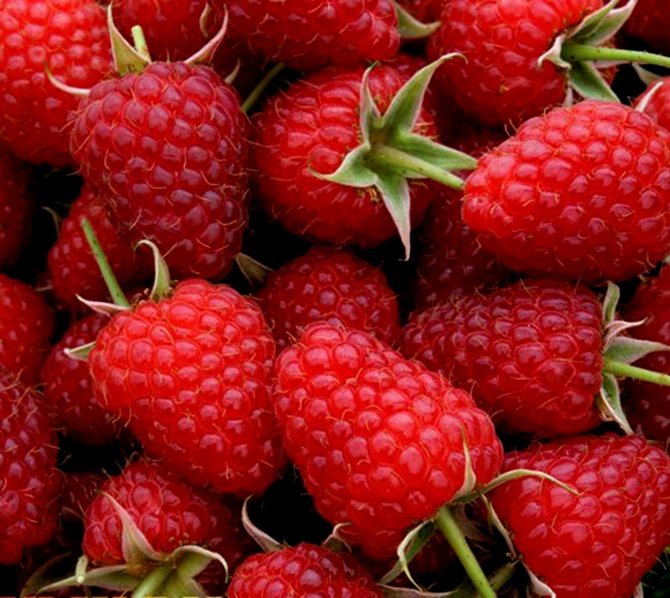

As beautiful as Polka berries are, they are just as tasty.
The berries are very beautiful, slightly elongated, reminiscent of a thimble. They are juicy, but not watery, with an average weight of 6-8 g.When fully ripe, the color is dark red. The seeds are small, almost invisible. The taste is sweet, but not cloying, with a pronounced raspberry aroma.
On the site, one plant of the Polka variety replaces 5–7 bushes of common raspberries.
Even ripe, Polka berries are hard enough, so they tolerate transportation well. The variety ripens rather late - at the end of July, but bears fruit for a long time - until the first frost.
A feature of remontant varieties of raspberries, to which Polka belongs, is the ability to produce crops on the shoots of the first year.
Pros and cons of the variety - table
| pros | Minuses |
| Beautiful tasty berries with sufficient density and practically do not emit juice during storage. | Needs proper feeding - with a lack of essential nutrients, it gives abundant growth to the detriment of the harvest. |
| High productivity. | |
| Long fruiting period. | |
| Small thorns. | Cannot tolerate heat and sun. |
| Rarely affected by pests. | Feels very bad on heavy and poor soils. |
| The crop is well stored and transported. | |
| The berries do not fall from the bushes. | Weakly resists diseases of the root system (rot, cancer). |
| With proper care, even frozen berries ripen. | |
| It successfully resists the main diseases of raspberries. | Possesses low frost resistance. |
| Suitable for commercial cultivation. |
Among the advantages of the Polka raspberry is an excellent yield
Video: what is good about Raspberry Polka
Polka breeding rules
Polka breeds in several ways:
- Green young offspring. They are certainly grown in a nursery and planted in a hole with a nutritious chatterbox.
- Young, stiff offspring. They are dug up in the second half of summer and immediately planted in a prepared place. Sometimes they are kept in the nursery for later planting. The seedling is shortened, leaving two to three buds above the root neck and a couple of leaves.
- By dividing the bush. The method is suitable for transplanting a plant to another place or when it is impossible to use other methods of propagation. The bush is removed from the ground in early spring or autumn and divided into parts. Each should have 2-3 young, developed shoots and healthy strong roots. The stems are pruned to 30–40 cm.
- Root cuttings. Raspberry bushes eventually form adventitious roots, on which many small offspring are formed. From the roots, those that are more than 2 mm thick are chosen, and cut them into cuttings. All cuttings should have 2-3 buds. They are then transferred to a nursery, placed in a mixture of compost and sand, watered daily and protected from the sun. When planted in spring, a full-fledged bush is formed from the root offspring by the fall. The survival rate of planting material is 60–80%.
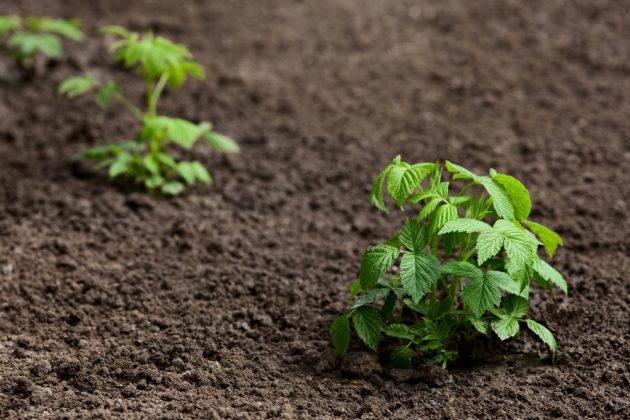

Rooted green offspring
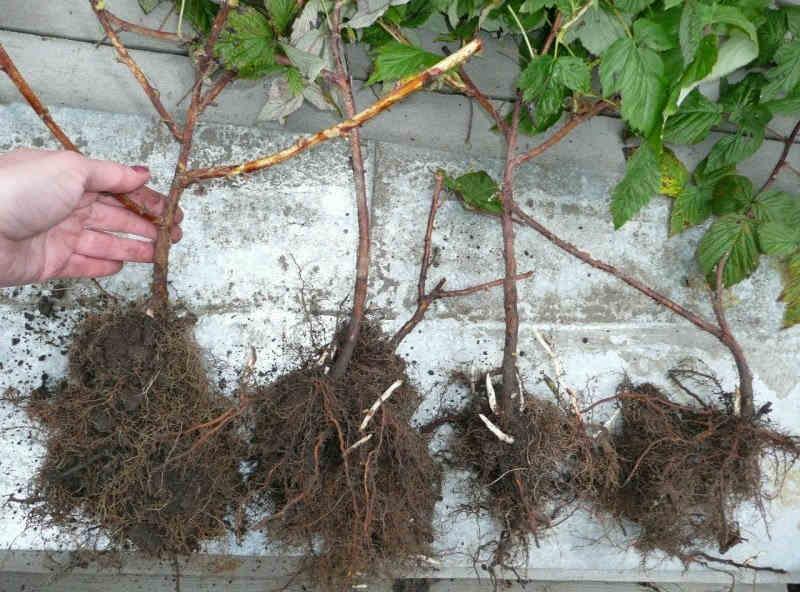

Young woody offspring ready to plant
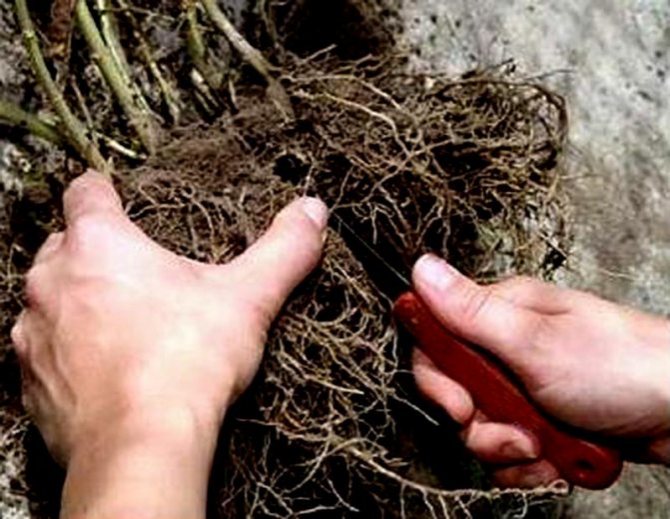

Reproduction by dividing the bush
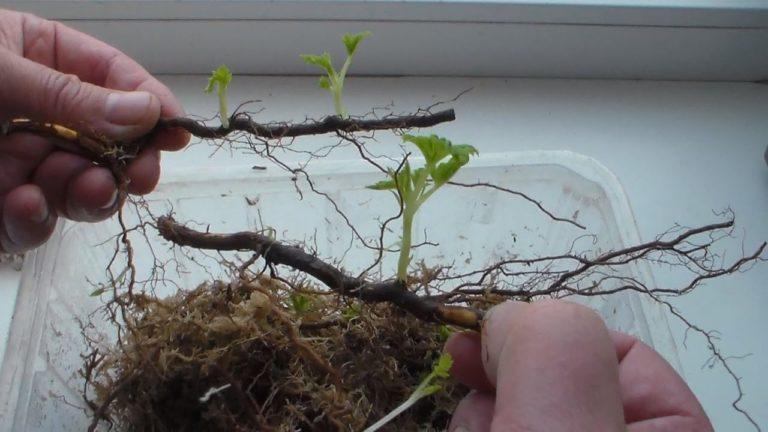

Preparation of root suckers
Planting and breeding
To grow raspberries and increase the number of bushes on the site, use seed or vegetative methods of propagation of fruit crops.
Seeds
Growing a hybrid raspberry variety from seed is a laborious and complex process that requires a lot of knowledge and experience. Therefore, the seed method of reproduction and cultivation of raspberries of the Polka variety is used mainly by scientists in the process of selection work.
Cuttings
Propagation of berry bushes by cuttings, which has long proven itself, is an easy way to grow a healthy, fruiting plant.
At the beginning of the summer period, young shoots are cut and planted in separate pots, brought into a greenhouse or covered with foil.
Once the cuttings are rooted, the plants are transplanted into open ground with fertile soil. At the end of summer, the seedlings are sent to their permanent residence.
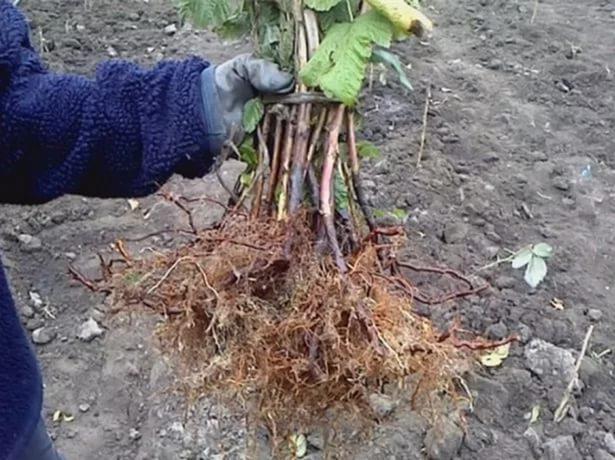

Dividing the bush
For dividing the bush, an adult, healthy plant is chosen. Raspberries are carefully dug out, the roots are cleaned from the ground and, using a sharp knife, are divided into equal parts.As a result of dividing the mother bush, 2 to 4 young seedlings with a developed root system are obtained. Plants are planted in separate planting holes and watered thoroughly.
Care features
Quality care ensures abundant fruiting of the shelf raspberries. The procedure for caring for a raspberry tree is standard and includes pruning, watering, loosening and feeding the shrub.
Pruning rules
Trimming a raspberry shelf allows you to form a bush consisting of 7 shoots. The order of work depends on the number of crops that are planned to be harvested:
- If a single crop is grown, the shelf raspberry is pruned in November. Branches are removed at the root.
- If the crop needs to be harvested twice, then the stems are cut in spring and autumn. The branches on which the berries were located, as well as dry and damaged stems are removed. On old shoots of raspberries, the harvest grows by summer, and on young ones - in autumn.
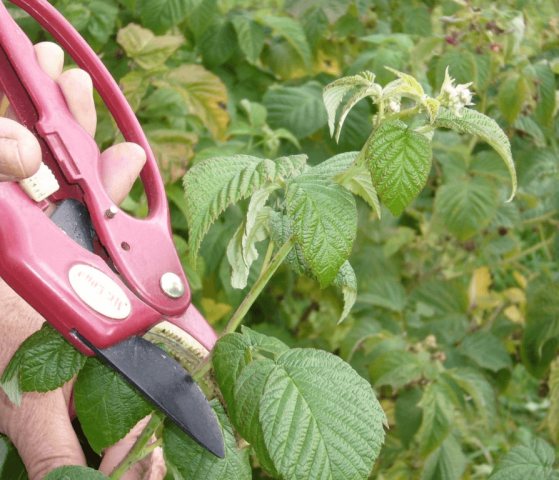

Watering and loosening rules
The polka variety needs constant soil moisture. The plant is watered during flowering and ripening of berries. If there is little rainfall in the fall, then winter watering is performed.
Each raspberry bush requires up to 3 buckets of water. So, soil moisture is achieved to a depth of 0.4 m.
Loosening the soil improves the penetration of moisture and air. At the beginning of the season, loosening is carried out before flowering to a depth of 7 cm. The procedure is repeated 5-6 times throughout the year.
Feeding raspberries
The use of fertilizers has a positive effect on the growth and yield of the shelf raspberries. The first feeding is done in the spring before the growing season. For this, an organic fertilizer is used, which is diluted with water in a ratio of 1 to 10 liters of water.
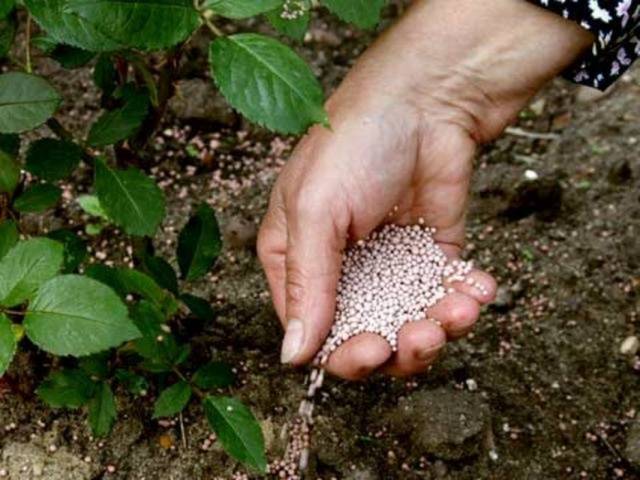

In the summer, feeding is carried out once a month. For raspberries of the shelf, ready-made complex formulations are selected containing ammonium nitrate, potassium salt, superphosphate.
In autumn, organic fertilizer is applied to the raspberry plant at the rate of 5 kg per square meter of the plot.
Testimonials
Anna, 35 years old, Volgograd
Refused all remontant raspberries in favor of this one. The variety is really quite capricious: it is afraid of drought, the soil on the site “eats away” in three years, then the raspberry tree has to be relocated. But the quality of the berries pays for everything: you rarely find such tasty and “correct” ones. Aligned, plump, sweet. They tolerate transportation perfectly, do not fall apart in jam and compotes, after defrosting they look like fresh. And the yield pleases: if you feed and water correctly, I collect 2.5 kg per bush per season without problems. The variety is good, I recommend it to everyone. You just need to choose the right nursery for buying seedlings. I got my Polkas the second time around. In the first, I ran into a re-grading.
Nadezhda, 52 years old, Podolsk
There is enough fuss with this variety, but the berries are very good. I like that fruiting is "long". My fruits begin to ripen in the last week of July, I harvest almost until the end of September. If it is autumn without early frosts, almost all ovaries ripen. I sometimes cut the latest ones together with the stems, and put them in a vase of water in the room. I won't say that berries ripened in this way are the tastiest, but it's nice that they can also be preserved. Before winter, I mow all the shoots and mulch thickly with humus. So far, not a single bush has died out, although they say that the variety is not winter-hardy. And in the summer I feed, water and clean the aisles from the overgrowth. Without this, the planting quickly overgrows, and yields fall.
Georgy, 56 years old, Pronsk
I planted several bushes of this variety the year before last. In principle, I was satisfied with it. The quality of the berries is very good, but there are not so many worries as they said. Care is almost the same as for any remontant raspberry: feeding, watering, pruning to the ground in the fall and mulching. The plants are compact, not thorny, I have not had any pain yet. There are a lot of berries (about 2 kg are obtained from a bush). They ripen, however, quite late, but the grandchildren are happy, they eat raspberries from the bushes even in September. I will multiply "Polka", it suits me perfectly.
Pros and cons of the variety
The main advantages of Polka:
- harvest: an average of 9 tons per hectare, cases of up to 12 tons per hectare are known;
- berries do not crumple, keep well on the bushes, easily tolerate storage;
- suitable for different types of workpieces - jams, juices, jellies, etc.
- small, weakly pronounced thorns, which makes harvesting easier;
- resistance to the most widespread raspberry diseases - both viral and fungal.
Disadvantages of the variety:
- requires pruning at the root and good insulation in winter;
- suffers from heat, if the temperature exceeds 30-35 °, needs shading of bushes and berries;
- with a lack of organic matter, potassium, nitrogen in the soil, the growth of stems decreases;
- strong susceptibility to root diseases - cancer, rot, etc.
Yield


It is advisable to supplement the description of the variety with a crop characteristic. Raspberry Polka bears fruit for three months - from late July to mid-October. Interestingly, the bushes yield crops even when the temperature drops to 0 or -2 degrees! Given the low frost resistance of the variety, this fact is striking. The yield from one bush is 4 kg.
Berries can be kept fresh for quite a long time due to their density. They perfectly tolerate transportation (they do not soften or ferment). Raspberries are also suitable for conservation. You can make jams, juices, fruit drinks and jellies from them. Berries do well from freezing: only 5% of the crop is spoiled.
Pest control
Garden pests can cause significant damage to the raspberry shelf. Most often, the raspberry plant attracts the stem fly, raspberry beetle, gall midge, weevil, and Putin tick. As a result, leaves, inflorescences, and raspberry stems are damaged.
All affected parts of the shrub are removed and then burned. The procedure is carried out in spring or autumn. When gall midge appears, the raspberry shoots of the shelf are cut off at the root.
The following measures help prevent the appearance of pests:
- leave free space between the bushes;
- the raspberry shelf is trimmed annually;
- in the fall, the soil is dug up;
- during the season, the soil is loosened under the raspberries;
- weeds are removed, which can become a refuge for insects.
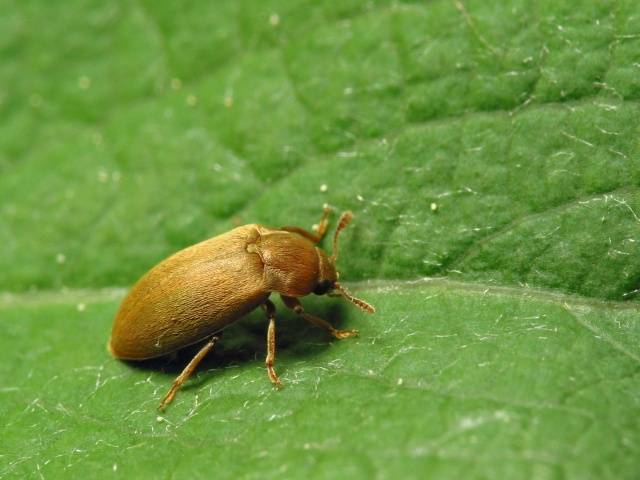

Main features of Raspberry Shelf
Ripe berries of this variety are conical in shape with blunt tips and are large in size. The length of the fruits can reach 3 cm, and the average weight is about 11 g, but with timely application of fertilizing, the maximum weight can reach 14-15 g. Berries are smooth, with a characteristic shine and slight pubescence, the color of ripe fruits is deep red.
On a note!
Taste qualities of Polka raspberries are pleasant, with juicy aromatic pulp, the amount of sugars and acids in them is balanced.
Drupes are small. The berries are dense, the drupes in them are firmly linked to each other, not watery, and do not decay for a long time after picking.
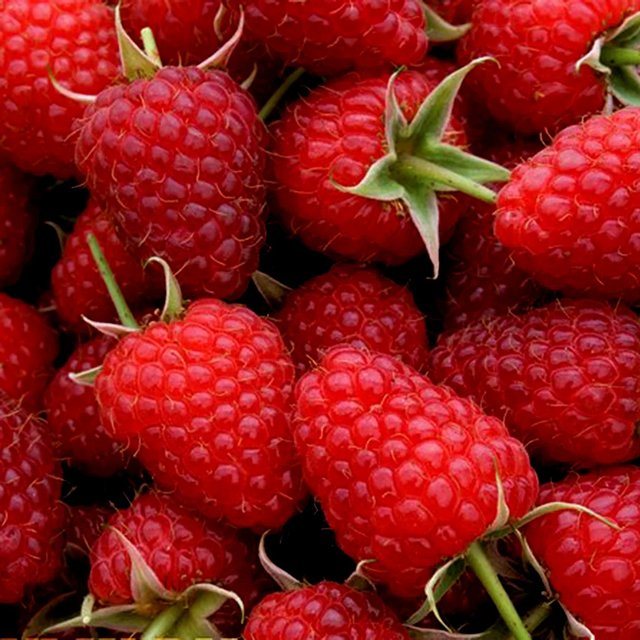

The fruits of this variety have one more advantage - worms do not appear in the berries.
The fact is that the fruits begin to ripen when the years of pests cease, and even May beetles lie in the soil until the spring.
The berries, even after ripening, are not prone to shedding; they easily break off the stalks entirely. And when growing raspberries Polka on an industrial scale, the harvest is harvested mechanically.
Things to remember
- Plant 50 cm apart... In order not to thicken the planting and give good growth to the plant, plant it at a distance of 50 cm from each other and 200 cm between the rows.
- Do not apply nitrogen fertilizers to the planting pits. When planting, use potash and phosphorus fertilizers, feed with nitrogen fertilizers during growth.
- Tie the bushes to the trellis. Even sturdy stems bend to the ground under the weight of the crop. To prevent loss of yield, tie the branches to the trellis.
Landing features
Timing
Remontant raspberries are planted at the same time as the usual species - in spring and autumn.With early spring planting, the root system quickly forms, the aerial part grows rapidly, and after 3 months the harvest ripens. The best time to root seedlings is autumn. They are planted in late September - early October, when it is still warm enough and the berry will have time to take root before the onset of cold weather.
Seat selection
This berry culture prefers light areas, preferably on the south side of the garden. It can grow in a shaded place, but at the same time the ripening of the fruits is delayed and the yield decreases.
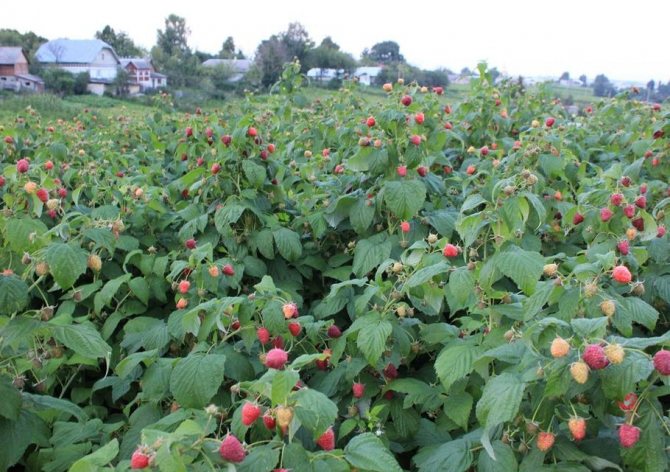

Choose a sunny place for the raspberry
- They choose an elevated place where there is no stagnant groundwater.
- The area for the raspberry tree should be well warmed up by the sun and protected from the wind. Therefore, it is preferable to plant bushes on the southern side of the garden near a fence or outbuildings.
- The repaired variety grows on any soil, but prefers loose and nutritious ones.
- Does not tolerate an acidic environment, therefore dolomite and lime are introduced into the soil.
- Every 8-10 years, raspberries are transplanted so that they do not lose their yield. You can put it in the same place in 5-7 years.
Important! You should not plant berry bushes where peppers, tomatoes, strawberries grew last year. The best predecessors are legumes, cucumbers, zucchini, squash, pumpkin.
For raspberries, unwanted "neighbors" are parsley, grapes, sea buckthorn - the joint cultivation of these crops has a bad effect on their productivity. As "friends" he prefers cucumbers, onions, carrots, red currants, apple trees, cherries.
Selection of seedlings
Before planting Polka raspberries, you need to take care of high-quality planting material. It should only be purchased in specialized stores or garden centers where plants are tested. The seedlings should have a well-developed fibrous root system, without damage and lethargy.


Seedlings should have fibrous roots without damage.
If the roots are a little dry, you need to hold them for a day before planting in Kornevin's solution, which stimulates the process of root formation.
Preparing for landing
The soil is prepared 2-3 weeks before planting:
- 2 buckets of humus, 250 g of wood ash and 150 g of complex fertilizer per 1 square meter are introduced into the soil. m.
- Strongly acidic soil is lime (600 g of lime per 1 sq. M).
- After fertilization, the soil is dug up and loosened.
Step-by-step disembarkation process:
- On the day of planting, dig holes, leaving at least a meter between the bushes, between the rows of 1.5-2 meters.
- Ash, chicken droppings are introduced into the pits.
- The seedling is lowered to the level of the root collar - to a depth of 6-7 cm.
- Spread the roots.
- Filled with soil and tamped.
- Water well - at least 5 liters per bush.
- Shoots are shortened to 25-30 cm.
- The trunk circle is mulched with dry hay, humus, sawdust, onion husks with a layer of at least 10 cm.
- The first days, young plants are shaded.
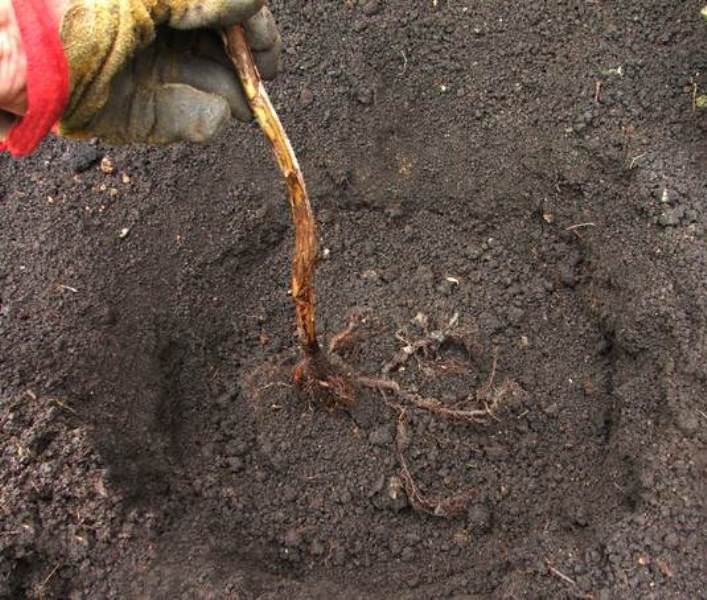

The seedling is lowered to the level of the root collar
Can be placed in rows. When laying a raspberry tree, for better illumination, it is placed from north to south. Humus is poured into the trench (1 bucket per 1 sq. M), 1 glass of ash, 100 g of ammonium nitrate are introduced and mixed with the ground. Roots with seedlings and buds are planted at a distance of 50 cm from each other. They are covered with soil, watered and mulched.
Healthy seedlings on prepared nutrient soil will take root well, quickly grow and begin to bear fruit.
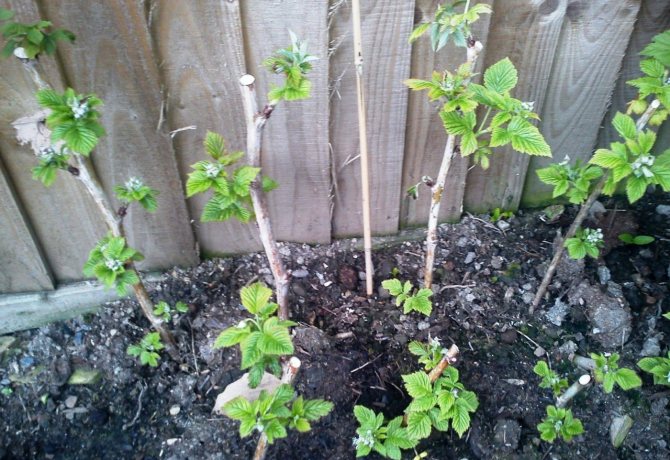

Polka shoots grow and bear fruit quickly in the first year of planting.
Important! Mulch protects the soil from overheating in the summer heat, prevents moisture evaporation, slows down the growth of weeds. In winter, it reliably covers the roots, protects from freezing.
How to prepare a plant for winter
Raspberry Polka is not highly frost-resistant, therefore:
- Its stems are not just bent down, but laid on the ground, fixed and insulated with at least two layers of agrotextile.
- Before frosts, the aboveground part of the plants is cut off, and the roots are well covered.Snow serves as a natural insulation for the roots and they tolerate frost well with minimal cover.
In cold regions, mulching compounds: straw or peat will provide protection to the roots. You can use tyrsu, but there is a risk of pulling on excess moisture. For hibernating raspberries, this is very dangerous, since a warm and humid environment is ideal conditions for bacteria and decay processes. That is why any watering of a culture already covered for the winter is prohibited. You can also put spruce branches on top of the mulch.
Possible diseases


Root cancer
It was already mentioned above that the variety is resistant to the main diseases of raspberries. It is practically not affected by gray rot, it is not attacked by a spider mite. Other small pests also do not attack the bush, since its flowering and fruiting occurs later than the main remontant varieties.
But the raspberry Polka has an "Achilles heel" - the root system. The most common disease is root cancer. Growths appear on the roots that reach the size of a walnut. The root system ceases to absorb nutrients and moisture - the plant dies. Disease is caused by bacteria. The only correct solution is to uproot and burn the bush. For prevention, acidic potassium-phosphorus fertilizers and gypsum are introduced into the soil.
With an excess of moisture or a lack of potassium, purple spotting may develop. Purple spots appear on the leaves. The affected plant parts are removed and burned. For prophylaxis, before flowering and after harvesting, the plant is sprayed with Bordeaux liquid.
Reproduction methods: description with photo
The Polka variety forms a minimum number of root suckers, so they are not destroyed during the summer, but used for reproduction. Shoots are separated from the mother bush when their height reaches 20 cm.
When single root suckers are not enough, the cuttings rooting method is used for propagation. The process technology consists of the following stages:
- A developed semi-lignified shoot is chosen and divided into segments 15 cm long.
- The lower part of the workpiece is made oblique at an angle of 45 degrees. To stimulate the growth of roots, bark incisions are made in the lower part.
- The stalk is placed in a container with water and the addition of a root formation stimulant: Heteroauxin, Kornevin.
- When filamentous roots 3-4 cm long grow on the handle, they are moved into the soil.
Planting a remontant variety Polka
Compliance with the rules for planting a shrub is an important condition for its development and maximum yield of fruits. The variety is grown in two ways:
- Kustov - in planting pits 40X40 cm, located at a distance of 1.5 m from each other.
- Private - in a trench 35 cm deep, with a gap of 2 m from each other. The distance between the bushes is 80-90 cm.
What kind of soil and place to choose?
The selection of the right site is an important condition for the successful development of the shrub and obtaining a rich harvest. The most comfortable conditions for growing a variety:
- Bright but soft lighting. It is good if a low tree with a sparse crown is located not far from the bush. In this case, the plant will have enough sun, and the berries will not suffer from the heat.
- Wind and draft protection. It is ideal to plant raspberries near blank fences, outbuildings, or on the south side of the house.
- For the roots, it is best to choose light loam. On more dense soils, before planting in the ground, add 2 buckets of coarse river sand per 1 m².
The nutrient content of the soil is increased by introducing the following substances per 1 m²:
- humus or compost - 2 buckets;
- superphosphate - 60 -70 g;
- potassium sulfate - 50 g;
- wood ash - 500 g.
When is the best time to plant?
For planting raspberries, periods are chosen when vegetative processes in the aboveground part of the seedlings are slowed down:
- in the spring, before the buds awaken, after the soil warms up to 15 ° C heat.
- in the fall, at the end of the ripening of the crop, 30-40 days before the onset of the first frost.
In the process of growing raspberries, traditional care measures are needed: watering and feeding, loosening and mulching the soil, pruning, protection from diseases and pests.
Frequency of watering and feeding
Adequate moisture is a basic requirement for plant care. Polka does not tolerate drought: the branches begin to dry out, and the berries become smaller. The soil should be moistened to a depth of 30-40 cm. Therefore, 2-3 buckets of water are poured under each bush.
Experienced gardeners prefer to moisturize raspberries by organizing drip systems. It is not necessary to purchase expensive options, it is enough to stretch a hose with holes to the bushes and turn on a weak water pressure for 1-2 hours every 1-2 weeks.
High yields with a long fruiting period ensure regular feeding. Fertilizers begin to be applied from the third year of the bush's life. Since the first 2 roots have enough nutrition introduced into the soil during planting.
The timing of fertilizing and the composition of fertilizers are as follows:
- In early spring, around mid-April, the soil under the bushes is spilled with chicken droppings or mullein.
- Before flowering and during the formation of berries, complex mineral fertilizers are applied with a sufficient amount of phosphorus and potassium. Wood ash is additionally poured into the aisles.
- In the fall, trunks are mulched with compost or humus.
Do you need pruning?
Experienced gardeners advise to grow Polka raspberries in an annual culture and carry out 2 pruning of shoots:
- In the summer, thin, weak branches are removed. For active fruiting and preservation of the large size of the berries, 6-7 shoots are left in each bush.
- In the fall, all raspberries are cut at the root. All removed stems are burned.
- To increase yields, you can use the Sobolev double pruning method.
How to prepare for winter?
The wintering of the bush is organized in two ways:
- With complete pruning of shoots, the soil is mulched with straw, peat or sawdust to protect the roots from freezing. Mulch is poured 2 weeks after digging the soil in the near-trunk circles by 7 cm, in the aisles - by 10-12 cm.
- To obtain a double harvest in spring, the tops of the shoots are pruned by 15-20 cm. In the fall, fruiting, dry and damaged branches are removed.
- If some of the shoots are left for the winter to trap snow, they are tied in a bundle and bent to the soil. Then the branches are fixed with a metal or wooden slingshot and covered with agrofibre or spruce branches.
Disease and pest control
The authors of the variety endowed it with resistance to many diseases characteristic of the culture. But the plant still retained its susceptibility to some ailments:
- Anthracnose - a fungal disease, manifested by the formation of purple spots on the leaves and shoots. The affected parts of the plant dry up and fall off. Spores of the fungus are destroyed by spraying the bush before flowering with Bordeaux liquid (3%).
- Verticillary wilting - one of the most dangerous fungal diseases. The pathogen affects the vessels of the plant and completely deprives the aerial part of nutrition. The infected bush begins to turn yellow and crumble. It is impossible to save the affected part of the plant. Therefore, with the extensive spread of the fungus, raspberries are uprooted and disposed of.
- Root cancer - a sign of the disease - growths on the root collar. The plant weakens due to impaired absorption of nutrients. The disease cannot be treated, so the bush will have to be dug up and burned. The only preventive measure for this pathology is the use of non-infected seedlings for planting.
In addition to diseases, insects can harm the bushes:
- aphid;
- spider mite;
- raspberry beetle;
- stem and shoot gall midge.
For the prevention and destruction of pests, insecticides are used: Karbofos, Aktara, Alatar, Fufanon. Processing can only be carried out before flowering. With later use, the poison accumulates in the fruit and becomes hazardous to health.
History of creation
This remontant was obtained from a Polish institute called Sadowniczym Zakładzie Doświadczalnym Instytutu Sadownictwa i Kwiaciarstwa in Brzezno. It was bred by the world famous breeder Dr. Jan Danek in 1993, crossing raspberries Autumn Bliss, which by the way is also one of the parents of another reference remontant - Zyugana, and numbered grade P89 141. In the same institute, in subsequent years, it will be bred many other excellent varieties of raspberries.
